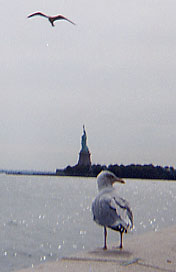

Thanks for coming in costume with literary and culinary treats to the Literary New York Halloween Party at the NYU Bookstore October 31, 2011 and making it such a success!
Major Authors: New York Writers
Fall 2011
LITR 1 DC 6282. 001 September 12 - October 31st
LITR 1 DC 6282. 002, November 7 - December 19th
New York University
McGhee Division
4 Credits. 2 credits for each short semester.
Professor Julia Keefer
julia.keefer@nyu.edu
https://pages.nyu.edu/keefer/twenty/contnyc.html
212-734-1083
Office Hours: Before and after class, Wednesdays at the NYU bookstore between 4-6,
Saturday mornings at Coles, before and after literary readings and optional NYC events,
Online all the time
Course meeting time: Monday evenings 6:30-8:50 in the Reading Room on the 9th floor of the Bobst Library
Semester I: September 12 – October 31st
Semester II: November 7 – December 19. Meeting in the lower level of 7 East 12.
The first section is not a prerequisite for the second semester. You may register for either or both semesters. Community literary reading times may vary.
No Pre-Requisites. Students from CAS, Gallatin, and Steinhardt can and did take the course.
Course Description
These two 2-credit consecutive semesters, open to all majors, seek to investigate contemporary literary movements in the Greater New York area. We will do close readings and analyses of the novels, short stories, essays, and poems of writers now living in the greater New York area and meet some of them at literary readings at the NYU Bookstore, Book Court, McNally Jackson, the Brooklyn Book Festival, and the 92nd St Y.
Course Activities
Oral presentations, discussion in class and around the city, Blackboard Forums, and attendance at literary readings are all important course activities. We will start class with a 30 minute NYC poetry slam where each student reads a poem aloud of their choice from the anthologies. Then we will spend two hours discussing the book of the week and going over their written close textual analyses on it. When we attend literary readings we will chat before and afterwards if possible. Hard copies of close textual analyses must be handed in to me at literary readings. Friday morning Discussion Board in Blackboard will help
with close textual analysis. October 31, 2011 will be a Literary New York Halloween party at the NYU bookstore. Come in costume. Bring tricks, treats, friends, family, and poems, dramatic monologues, and/or prose passages to read that describe New York and Brooklyn in gorgeous, startling, or unusual language. This will also be a philanthropic event.
Questions for reflection: During the semester, here are some questions to focus your reading and help you choose a thesis for your final paper.
1) How has the representation of September 11 influenced contemporary New York authors and moved readers through specific style, structure, and characterization?
2) How are the sounds and senses of New York represented in New York poetry?
3) What is a great sentence in both the maximal and minimal styles, contrasting writers like Moody and Egan, Hamill and Whitehead, or De Lillo and Safran-Foer?
4) How do the authors connect emotionally to New York? Do they hold a distinctive view of the city?
5) How do narrators and characters respond to their environment?
6) How does the dramatic structure of a given book compare to its narrative style and sequencing?
7) Are syntax, typography or word choices influenced by descriptions of the city?
Course Objectives
To improve skills for close textual analysis
To sharpen and deepen critical thinking
To improve writing skills and oral communication
To learn more about the literature of New York
To meet NYC authors, hear them read, and talk to them about their work
To compare and contrast the styles and structures of different NYC literary works
To discuss the literature with each other in fun, friendly forums
Required Reading
First semester, September 7 –October 31st. LITR 1 DC 6282.001
The following are your TEXTBOOKS but buy them USED at the NYU bookstore!
Falling Man by Don De Lillo
Let the Great World Spin by Colum McCann
Extremely Loud and Incredibly Close by Jonathan Safran-Foer
The Colossus of New York by Colson Whitehead (short poems)
The Black Veil by Rick Moody
Invisible by Paul Auster (Harlem Redux or Black Orchid Blues by Persia Walker optional)
II. Second semester, November 7 – December 19th. LITR 1 DXC 6282.002
A Visit from the Goon Squad by Jennifer Egan
The Kid by Sapphire
Thoughts without Cigarettes (Mambo Kings Play Songs of Love, optional) by Oscar Hijuelos
Chronic City ( The Ecstasy of Influence optional) by Jonathan Lethem
Forever(Tabloid City optional) by Pete Hamill
Reference Books for both semesters:
Required: Writing New York by Philip Lopate, New York Poems, Literary Brooklyn by Evan Hughes
Optional: How to Read a Poem by Edward Hirsch, Manual by Justin Long-Moton, Reading like a Writer by Francine Prose, and How to Write a Sentence by Stanley Fish
Course Requirements
Because these are short semesters, ALL writing grows into the final 10-20 page paper. Book discussions due by Friday every week in Blackboard; your weekly close textual analysis due every week in class and the poems you choose to read aloud can all be used in the final paper. Individual conferences will be scheduled to discuss this final paper.
1) Weekly Written Close Textual Analysis of chosen passages. After triple-spacing the chosen passage, your analysis should be at least two pages single-spaced. Bring two hard copies to class every Monday. Use my notes from my e-book Carving Your Story to help you write a close textual analysis.
2) Before Friday morning submit an entry into the thread on that week’s book in Blackboard. This is not extra work as it will help with close textual analysis.
3) Bring a poem from Writing New York or New York Poets to read aloud every week that we meet in the classroom for the first semester. Tell us why you chose it and how it relates to your project. This is only required for Semester One to prepare for the New York Word Symphony at the Halloween party. During the second semester, you can work on your My New York essay.
4) Discussion and Participation in weekly classes. You cannot get an A if you miss more than one class. Do not email me if you have to miss class. To be fair to all students, you should not try to get special treatment. The syllabus is detailed enough so that you can keep up. I also have conference time 30 minutes before class as well as at all literary readings and events.
5) Final paper should be around 10 pages and is a guiding question or thesis developed in your Forum using your weekly analyses as evidence and reference.
Semester 1: Final paper due October 31.
Semester II: Final paper due December 19
Blackboard
Besides the syllabus in Blackboard, (please print and bring to class) which is also at https://pages.nyu.edu/keefer/twenty/contnyc.html, we will use the Discussion Board or Forums every Thursday. Use student will read the entries on the weekly thread and that book and post a comment using as many of the following questions as possible to analyze what you are reading.
1) What is a great sentence and how do the parts of the sentence relate to each other to produce what effect?
2) How is tone color, such as onomatopoeia, assonance, consonance, and alliteration, used in fiction?
3) How are metaphors, similes, personification and other figures of speech used?
4) What kind of rhythm do you find in this prose? Please scan it and then analyze it in terms of content.
5) What are the narrative voices and styles of this novel or memoir?
6) How do character motivations fuel dramatic structure?
7) How do character transformations feed the story arc?
8) What is the narrative sequencing and how does this reflect the theme and the style?
9) How does the author juggle with character orchestration and does this help or hurt the theme and dramatic structure?
10) Which kind of imagery--visual, olfactory, gustatory, kinesthetic, aural, or tactile--is most prevalent in this writing and how does this color the content?
11) How does typography such as that used in A Visit from the Goon Squad or Extremely Loud and Incredibly Close or the conventional layout in other books (chapter titles, breakdowns, italics etc) deepen the theme, central dramatic question, and structure?
12) What is the difference between the theme and the central dramatic question and how do they play off each other as the story progresses, regresses, or spins in stasis?
13) How does the dramatic structure differ from Aristotelian or Hollywood plot points and what does this do to the levels and layers of conflict?
14) Since the author is not necessarily the narrator, except in memoir, how is the author's life and voice absent or present in the writing?
15) How is the subtext fabricated by the secrets, shame, and lies of the characters and what does this bedrock due to the dramatic momentum or stasis?
All these style and technique forums should relate in some way to the content of the contemporary New York culture.
Hard Copies for Class
2 copies of your close textual analysis
2 copies of the weekly poem you chose
Course Outline
The following breakdown is subject to changes, based on the availability of writers and book tours.
Semester I: September 12 – October 31
September 8: Thursday at 7 at McNally Jackson. Granta.
September 9: Friday at 7 at Book Court in Brooklyn for a Ten Years Later Retrospective. (optional)
September 12: Introductory lecture and discussion. Setting the scene of 21st Century New York Literature
Meet Evan Hughes of Literary Brooklyn at the Book Court on September 13 at 7. (optional)
September 17: 2-5. Meet Paul Auster et al at Community Bookstore in Brooklyn.
Brooklyn Book Fair on September 18: This year’s festival features Jennifer Egan, Colson Whitehead, Pete Hamill, Paul Auster, Siri Hustvedt, Jhumpa Lahiri, Amy Waldman, Jonathan Safran-Foer, Nicole Krauss, Pulitzer Poets, international authors and multi-media and culinary events. The festival is free and runs from 10 to 6 with events at Borough Hall and all over Brooklyn. There is a beautiful earth show in the new park on the waterfront at 7 and then we could walk back across the Brooklyn Bridge as the natural light fades and city lights sparkle. Or some of you could attend the Brooklyn Bash at 8 with Colson Whitehead et al.
September 19: Don De Lillo. Falling Man. (optional Cosmopolis as background)
Pete Hamill at NYU Bookstore on September 24 at 4. (optional) Edward Hirsch is talking about his poetry book at the 92nd St Y this afternoon as well.
September 26: Meet at WTC memorial if we can at 6:30. Discussion of Safran-Foer Extremely Loud and Incredibly Close.
October 1: Poetry Reading in the Bronx Botanical Gardens at 4. (optional)
October 3: Let the Great World Spin by Colum McCann.
October 10: On site holiday. Don’t come to the classroom. Forum discussion due Thursday October 13.
October 17: The Black Veil by Rick Moody.
October 18: Poet Charles Simic at the NYU Bookstore. 6:30. (optional)
October 20: Colson Whitehead at McNally Jackson at 7. Meet at 6:20 at Indian restaurant a block west on Spring St if you like. (optional) Get signed copies of Colossus of New York and his new Zone One!
October 24: Invisible by Paul Auster (optional Harlem Redux, Black Orchid Blues by Persia Walker, one of our Halloween guests) Compare thrillers.
October 31: Final due for Section I. Celebrate with a Halloween party at the NYU Bookstore. Final paper is 4 edited CTs, as well as some kind of oral presentation of New York poems, dramatic monologues, and prose passages, in costume or not, with the New York Word Symphony. Guests are Justin Long-Moton, Persia Walker, Todd Anderson, Thomas Fucaloro, Cyd Fulton and class members.
Literary Halloween at the NYU Bookstore. October 31, 2011
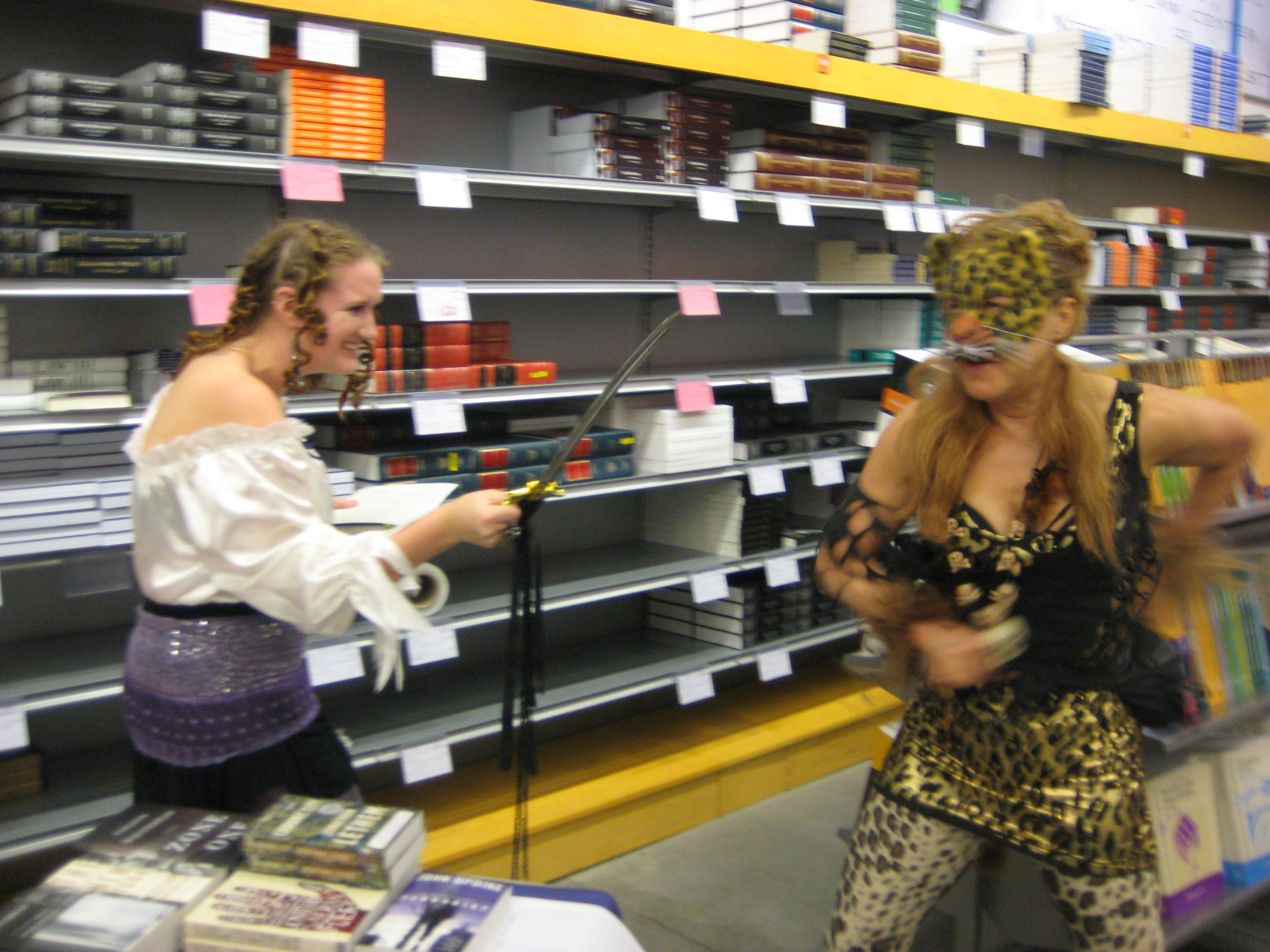
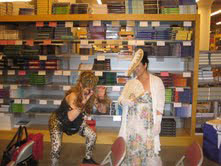
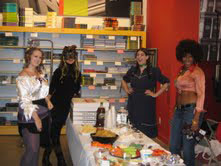
COURSE OUTLINE: Semester II: November 7 – December 19.
You don't have to bring poems every week this semester as we will be all over town. Instead, revisit your My New York essay, carry a notebook on it, and develop it as we travel around meeting authors. CTs are still due every week on site preceded by Friday discussions in Blackboard. You must buy tickets to the 92nd St Y immediately to see Egan, Sapphire, and Hijuelos.
New Classroom is LL33, 7 East 12! But we will only be there November 7, November 28, December 12, and December 19. Otherwise we will be at literary readings meeting the authors, usually at the 92nd St Y. We will have at least 60 minutes of class before we meet them at a local cafe so bring 2 hard copies of your CTs for that week.
November 7: Introduction to Section II. To introduce new students to the themes and questions of the course, Alumni from the first semester will summarize and analyze what happened in the first half of the semester and lead discussions. Work on My New York essays as well. Lecture on literary analysis.
November 8: Meet Jonathan Lethem at the Brooklyn Book Court at 7.
November 11: Blackboard discussion of Chronic City.
November 14: Bring 2 copies of CTs of Chronic City. A Visit from the Goon Squad by Jennifer Egan at 92nd St. Jeffrey Eugenides who also won the Pulitzer Prize will talk with Egan. Y on Lexington. Meet at 6:10 at Marmara restaurant, 93rd and Third.
November 17: Blackboard discussion of A Visit from the Goon Squad.
November 19: Poetry Reading in Bronx Botanical Gardens at 3.
November 21: Bring 2 CTs of A Visit from the Goon Squad. Meet at the 86th St. Barnes and Noble café near 6 Subway. Writers on Writers William Carlos Williams at 7. Optional tour of UES. 92nd St Y at 8 on Monday to hear Sapphire, the poet and fiction writer, read from The Kid with Sherman Alexie's War Dances.
November 26: Blackboard discussion of Sapphire.
November 28: Meet in the classroom LL33 7 E 12. Bring 2 copies of compare/contrast of Sapphire, Egan, and Lethem in one document.
November 29: Meet Don DeLillo and Paul Auster at the Barnes and Noble Union Square Granta event at 7. But get there at 5 as it will be full.
November 30: GSAS/CAS Professors poetry reading at the NYU bookstore.
December 1: Edgar Allan Poe performances at NYU Law School. 6-8 pm.
December 1-2: Elizabeth Bishop performances by Gallatin school around campus, afternoon and evening.
December 2: Blackboard discussion of memoir and Hijuelos.
December 3: 2pm. Meet at White Horse Tavern for a Literary Pub Crawl. (optional) This is a 3-hour pub crawl where actors recite poetry by Dylan Thomas, ee cummings et al, and we look at the architecture of favorite haunts and homes of famous authors from the Literary Greenwich Village period.
December 5: Life Without Cigarettes by Oscar Hijuelos at 92nd St Y on Lexington Avenue at 8. Meet at the Chinatown East restaurant at 6:00 on Third Avenue between 92 and 93. Bring 2 copies of CTs of this book.
December 8: Blackboard discussion of Pete Hamill.
December 9: E. L. Doctorow in the Rosenthal Pavilion of the Kimmel Center at 7 pm. First come, first-served.
December 10: Literary tour of Harlem. Meet at Steps Dance Studio at noon, Schomberg Center for Black Culture at 1. We will visit homes of Langston Hughes, James Weldon Johnson, Ralph Ellison et al and see Strivers Row from Walker's books, then go to CCNY where Hijuelos and Sapphire studied then up to Inwood to see the places in Hamill's and Lethem's books.
December 12: Bring 2 copies of CTs of Forever by Pete Hamill. Meet in the classroom.
December 19: Meet in the classroom. Bring two copies of your My New York paper to read aloud. My New York should be at least 10 pages and can include creative and critical work about your experience of New York and what you learned from reading our major New York authors. Possible trip to Bar 13 for the poetry slam at 8 or 8:30.
EVALUATION AND GRADING CRITERIA
RUBRIC FOR MAJOR AUTHORS: CONTEMPORARY NEW YORK CCCC 4 times 25 equals 100
Criteria |
Superior work (A) 23-25% |
Exceeds expectations (B) 19-23% |
Meets expectations (C) 14-18 % |
Below Expectations |
Does not meet expectations (F) below 11% |
Control of correct English |
Shows mastery of conventions of English grammar and syntax and writes fluidly with coherence and authority in correct MLA style |
Good control over conventions of English grammar and syntax; wring could be more fluid and coherent, a few proofreading errors |
Inconsistent control of conventions of English grammar and syntax, writing is often choppy, voice lacks power and persuasiveness |
Often lacks control of conventions of English grammar and syntax, voice is weak or inadequate, MLA style is not used |
Unable to handle conventions of English grammar and syntax, no voice is present, no mastery of MLA style |
Connotative |
Shows mastery of the vocabulary and use of figures of speech, tone color, rhythm, rhyme, style, structure, and sequencing and other elements that appeal to the senses and imagination and how this connotative language is connected to content and theme |
Has good insight into connotative language and aesthetic devices but doesn’t always see the deeper implications or connection to content and theme |
Limited understanding of connotative language and aesthetic devices, makes a few connections between form and content but needs to further study |
Minimal understanding of connotative language and aesthetic devices, is unable to connect the literary art to theme, content, or characterization; has minimal feeling for the aesthetic aspects of language |
Has not studied the Lessons on Close Textual analysis and has no understanding of connotative language nor |
Cultural awareness |
Has full insight into the contemporary time period in terms of style and structure as well as characterization and theme and compares and contrasts with sensitivity |
Has good insight into the contemporary time period, but sometimes has blind spots or fallacious assumptions when comparing and contrasting |
Inconsistent insight into the
|
Has poor insight into the contemporary New York literary movements in terms of style and content |
No understanding of the contemporary New York literary movements in terms of style and content |
Control of Claims, Counterclaims and Questions |
Able to name and develop ideas fully, pursuing questions, developing claims, and refuting claims in a fluid, coherent writing style that links the connotative analysis and comparison and contrast to the student’s thesis through example and accurate interpretation |
Controlling idea present and developed. One idea is connected to another, but some of the counterclaims may be missing; the thesis is good but not excellent; some of the questions may not be pursued; a few more examples may be needed |
Controlling idea present, but not fully developed. Inconsistent ability to link ideas together. |
Controlling idea not present and not developed. Weak connection between ideas. |
No controlling idea present. No links between ideas. Little or no development. |
Sample Papers
Comparison/Contrast by Niq Ishaq
Comparison/Contrast by Cathy Abell
My New York by Cyd Fulton
Optional Readings (This is just a bibliography; none of these books are required but may be useful as background, reference, or future reading)
Jazz by Toni Morrison
Selected Poetry by Langston Hughes
Bonfire of the Vanities by Tom Wolfe
Age of Innocence by Edith Wharton
The Great Gatsby by F. Scott Fitzgerald
Breakfast at Tiffany’s by Truman Capote
Writing in Restaurants and Oleanna by David Mamet
Long Day’s Journey into Night by Eugene O’Neill
Angels in America by Tony Kushner
Washington Square by Henry James
The Harp-Weaver and other Poems by Edna St. Vincent Milay
Collected Stories of Willa Cather
Terrorist by John Updike
Letters of Allen Ginsberg
Fault Lines by Meena Alexander
The New York Trilogy, Moon Palace, Sunset Park, Brooklyn Follies by Paul Auster
The Keep, Look At Me, Emerald City and other Stories by Jennifer Egan
The History of Love and Great House by Nicole Krauss
What I Loved, The Sorrows of an American, The Shaking Woman, Women without Men by Siri Hustvedt
Motherless Brooklyn, The Fortress of Solitude by Jonathan Lethem
Mambo Kings by Oscar Hijuelos
The Intuitionist and Zone One by Colson Whitehead
Fury by Salman Rushdie
Waterfront: A Journey around Manhattan by Phillip Lopate
Netherland by Joseph O'Neill
Empire City by Jackson and Dunbar
Four Fingers of Death, The Ice Storm, Right Livelihoods by Rick Moody
Between Two Rivers by Nicholas Rinaldi
New York the Novel by Edward Rutherfurd
The Emperor's Children by Claire Messud
Metropolis Case by Matthew Gallaway
Overnight, Breakers by Paul Violi
Netherland by Joseph O’Neill
Inherent Vice by Thomas Pynchon
Unaccustomed Earth by Jhumpa Lahiri
Brooklyn by Colm Toibin
Eight White Nights by Andre Aciman
Tree of Codes by Jonathan Safran-Foer
The Big Empty by Norman Mailer
Manahatta by Eric W. Sanderson
Blue Angel by Francine Prose
Wake Up Sir by Jonathan Ames
The Privileges by Jonathan Dee
The Assistant by Bernard Malamud
Reruns by Jonathan Baumbach
Money by Martin Amis
Absurdistan by Gary Steyngart
Last Exit to Brooklyn by Hubert Selby
The Submission by Amy Waldman
New York poetry anthologies for inspiration and special projects
http://www.poets.org/state.php/varState/NY
Cambridge Companion to the Literature of New York edited by Cyrus Patell and Bryan Waterman
END OF SYLLABUS. See below for links, notes, and other inspiration.


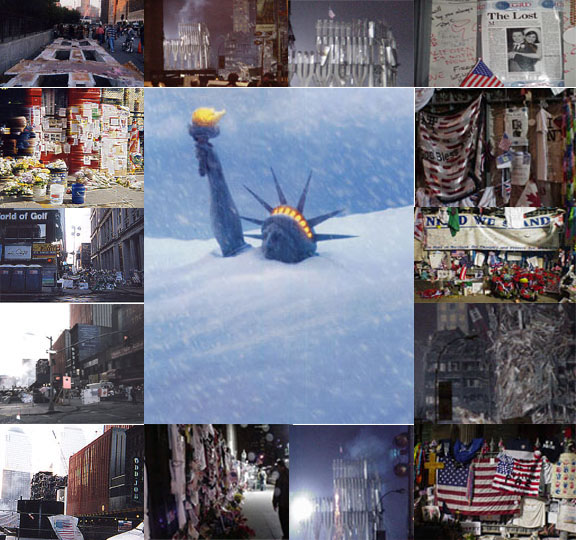

 |
Frank O'Hara |
John Ashbery |
|
Muriel Rukeyser |
|
Louise Glück |
|
Billy Collins |
|
June Jordan |
Other New York Poets
McGhee is blessed with many NYC poets on the faculty such as Master Teachers Ruth Danon and April Krassner, Catherine Barnett, Elena Rivera, Michael Coppola, Andy Levy, et al and the late Paul Violi.
Web sites
http://www.fakehead.com
Max Lakner et al run this fabulous Web site about hyper-reality, the "New York-ification" of the mind. Fakehead accepts submissions for critical essays, non-confessional poetry, and genius napkin scribbles! Hard copies are available at Book Court and St. Mark's Books.
Qualifications of Professor Keefer for this course
PhD from NYU, two Masters Degrees in literature, drama, oral interpretation, and media
20 years experience teaching adult students
Creative (a trilogy of novels, especially Un-Clashing Civilizations) and critical publications during this time period—1990-2011
Presentation of paper at the post-9/11 NYC Literature Conference at the University of Westminster, London in 2008
Professor Keefer was chosen as the PhD external advisor for a doctoral Egyptian student at Al Azhar because of this specialty as he is writing his dissertation on about contemporary American literature.
At the 2010 NEMLA conference in Montreal, Professor Keefer followed the contemporary New York and urban pastoral track for American literature. (For global literature, she did French and Middle Eastern tracks.)
Weekly attendance, every Monday night, at NYC literary readings at the 92nd St Y and throughout the greater NYC area
PEN member
Faculty Participant for the Health and Humanities Initiative of Bellevue Literary Press
Co-founder, Media Relations, and Coordinator for Literary Club at McGhee
Currently writing a novel that begins in New York in 2010
Lifetime Commitment to McGhee students
Course Lectures
Sometimes literary communities can oust their founders, or vice versa: “Brooklyn is repulsive with novelists, it’s cancerous with novelists. That can sometimes be too much when you need to also be inside yourself, exploring your own meandering feelings, not dictated by your environment, but dictated instead by what you read that day, or something else.”(Jonathan Lethem) (Come and meet Lethem at Book Court November 8 because he now lives in California.)
In Brooklyn's defense, first-time Fort Greene author Carey Wallace, who recently published The Blind Contessa, said, “The vibrant literary scene in Brooklyn — and the noise and ‘traffic’ it generates — aren’t something I’m likely to take for granted — let alone complain about," adding, "In my experience, a writer’s only weapon is their ability to direct the traffic in their own head. As far as I’m concerned, the level of ‘mental traffic’ here in Brooklyn keeps us in fighting shape. It’s not an edge I’d want to lose."
We will debate the following Franzen claims:
Feel free to disagree with all of the above--I do. (Keefer)
Write out a passage from the book, approximately one page, triple-spaced, numbering every line. The triple spaces are for you to analyze meter, long and short stresses, or note figures of speech, and to really focus on the exact words the author has written. Mark up this passage but do not write your essay in between these spaces. Your analysis comes after the passage in standard MLA format with good sentence structure and paragraph progression. Do not do bullets and bytes. In the age of the Internet, it is easy to get literary analyses and critical theory, so it is important for you to focus on your initmate relationship with the text and what it means to you. As such, I will not be giving examples of the ideal textual analysis. In fact, there is no ideal analysis, because every text is different and you are all different from each other. It's not objective like arithmetic. This lesson will give you guidelines to help you with the vocabulary and structure of analysis, but you must make it your own, edit it, and improve upon it throughout the semester. At this introductory level, pass/fail grades are given because analyses can always get better. I know a PhD candidate who has been analyzing Yeats for the past forty years. Be patient with yourselves, read closely, and focus carefully, but use your imaginations to interpret the text your way.
Analyze the passage for denotative and connotative meaning, relationship to the rest of the text, rhetorical devices, structure, and aesthetics. Even though you are concentrating on a single passage, it is important that you read the entire work to understand its relationship to the whole. First of all you must understand the denotative and connotative meanings of every word in the text. Use your thesaurus and dictionary frequently so that you understand every possible meaning, even when you think you know what is being said. Then analyze sentence structure (simple, complex, compound, compound-complex) and paragraph structure and progression in a novel or short story, dialogue and action in a play, prosody if a poem. Most of your works are novels but you should also know how to analyze poetry.
When you analyze language, place close attention to both diction, or choice of words, (formal, informal, colloquial, concrete, abstract) and rhetorical devices. Even prose passages can be scanned to determine rhythm. It is not enough to identify these devices-- you must relate them to the whole, and evaluate their impact on story, dramatic structure, narrative voice and sequencing, aesthetics, meaning, and character objectives.
This first close reading focuses on the HOW of the text, how the writers created the beauty and meaning from the words they chose arranged as they saw fit. By understanding prosody, style, and structure you can get better breakdown the passage into its components. Then you can ask the WHY questions that connect this form to content. Language is a symbolic and metaphoric art. To be successful, the readers must translate these black lines on the white page into images, feelings, and thoughts in their minds that bring the world to life. It may not be the exact world the writer intended, which is part of the reader-response criticism discussed in the literary theory Lesson.
Does the passage describe a natural or artificial scene and what is the degree of plausibility, suspension of disbelief? How vivid and explicit is the descriptive language? To which senses does it appeal most? Does it describe character as monologue or dialogue, explicit or unconscious? Does it describe an action, develop an argument or an idea connected with the larger world of the fiction? How is the passage sequenced, in other words, what comes before and after, and why? How does this relate to the overall dramatic structure? Is this a passage devoted to exposition, complication, turning point, crisis, climax or resolution? What are the levels of empathy or emotional involvement? Comedic techniques or devices to increase suspense and drama? In what person is the novel told? In a drama, how successfully are the characters orchestrated? How is language used aesthetically to develop theme and how his theme related to the central dramatic question and the protagonist's objectives? In this global literature course, how do style and structure reflect the taste of the indigenous culture? How does this passage compare with another one on the same content, but from a different culture? For whom is the story written? How does the narrative voice relate to audience?
After thinking about all of the above, let us go into detail on the various sections. Part I Lesson I focuses on Form, while Part II focuses on content.
FORM
Meter in poetry or grammar, sentence length, paragraph progression in prose
Rhythm in stressed and unstressed syllables
Rhyme where applicable
Tone Color including alliteration, assonance, consonance and onomatopoeia
Figures of Speech including metaphors, similes, personification, analogy
Read aloud your triple-spaced passage and note the sentence length, paragraph progression or prosody in poetry. How long or short are the lines, sentences, and paragraphs? What effect does this have? Always relate form to the overall meaning. In translated works, you can still analyze the length of lines, sentences and paragraphs but not the exact meter, rhythm or tone color. These are reserved for works written in English.
Meter is analyzed in terms of metric feet--iamb,u_ trochee,_u anapest, uu_dactyllic, _uu, spondee, __pyrrhic,uu. Most British poetry is written in iambic pentameter. A spondee has a finality about it while a pyrrhic is light, an anapest is a waltz rhythm, and a trochee makes you stop and think backwards.
Rhymes can come at the end of the line and a rhyme scheme can look like this A B A B C D E C D E FF, refering to the end of the line, but rhymes can also be internal. In Part III of my trilogy I have the Electroweak Force narrator talk in rhymes because it mimics the electrons. What do rhymes do to the meaning of the piece?
Words are letters taking up space on a page that when read aloud form a pattern in time. What is the overall affect of this pattern related to the meaning of the book?
Tone color relates to the sound of the words, like movement quality amplifies dance, resonance music, and color painting. Alliteration is the repetition of the first sound like "Peter Piper picked a peck of pickled peppers." Consonance is the repetition of consonants like "Sister Suzie sells seashells down by the seashore." Assonance is the repetition of vowels like "How now, brown cow." Onomatopoeia occurs when the tone color mimics the sound of the thing described, such as "babbling brook." There are many categories of tone color, but see how the style determines how you feel about the characters and their thoughts and actions and how you experience the setting.
Figures of Speech refer to words that are used to connote other things or feelings than what is being literally described. A simile uses like or as if, such as, "her eyes are like seashells," while a metaphor says something is something it is not, such as "her eyes are seashells." Personification is the attribution of human characteristics to non-human entities such as the narrators in My Name is Red or Part II of my trilogy. Obviously, trees, dogs, cats, the Statue of Liberty, the Sphinx etc cannot speak English but we personify them to give depth and breadth to a story.
Even in translation you can evaluate figures of speech. What do they do to the experience of the passage? Some Native American writers prefer literal words and meanings because the sky and the sand are good enough, while writers like Virginia Woolf make put diamonds on waves, and describe nature in terms of human beauty. What do the figures of speech reveal about the narrators, characters and their worlds?
Rhetorical Devices
Using selections from All Quiet on the Western Front as examples, please review the following to help you with close textual analysis:
Humor, with metaphor: "My arms have grown wings and I'm almost afraid of going up into the sky, as though I held a couple of captive balloons in my fists."
Personification: "The wind plays with our hair; it plays with our words and thoughts."
"Over us Chance hovers."
Euphemism: "At the same time he ventilates his backside." "All at once he remembers his school days and finishes hastily:'he wants to leave the room sister.'"
Imagery: "To no man does the earth mean so much as to the soldier. When he presses himself down upon her long and powerfully, when he buries his face and his limbs deep in her from the fear of death by shell-fire, then she is his only friend, his brother, his mother; he stifles his terror and his cries in her silence and her security; she shelters him and releases him for ten seconds to live, to run, ten seconds of life; receives him again and often forever." (and personification) "The front is a cage in which we must await fearfully whatever may happen."
Repetition: "Earth!-Earth!-Earth!"
Antithesis: "A man dreams of a miracle and wakes up to loaves of bread."
Parallel Construction: "My feet begin to move forward in my boots, I go quicker, I run."
Simile: "He had collapsed like a rotten tree."
Metaphor: "Immediately a second [searchlight] is behind him, a black insect is caught between them and tries to escape--the airman.]
Liturgical prose: "Our being, almost utterly carried away by the fury of the storm, streams back through our hands from thee, and we, thy redeemed ones, bury ourselves in thee, and through the long minutes in a mute agony of hope bite into thee with our lips!"
Apostrophe: "Ah! Mother, Mother! You still think I am a child--why can I not put my head in your lap and weep?"
Allusion: "The guns and the wagons float past the dim background of the moonlit landscape, the riders in the steel helmets resemble knights of a forgotten time; it is strangely beautiful and arresting."
Hyperbole: "They are more to me than life, these voices, they are more than motherliness and more than fear; they are the strongest, most comforting things there are anywhere: they are the voices of my comrades."
Rhetorical question: "If one wants to appraise it, it is at once heroic and banal--but who wants to do that?"
Aphorism: "...terror can be endured so long as a man simply ducks--but it kills, if a man thinks about it."
Symbolism: "I pass over the bridge, I look right and left; the water is as full of weeds as ever."
Foreshadowing: "On the landing I stumble over my pack, which lies there already made up because I have to leave early in the morning."
Doggerel: "Give 'em all the same grub and all the same pay."
Short Utterances: "Life is short." (Analyse for rhythm and effect.)
Cause and Effect: "They have taken us farther back than usual to a field depot so that we can be re-organized."
Irony: "...a high double wall of yellow, unpolished, brand-new coffins. They still smell of resin, and piine, and the forest."
Appositive: "Thus momentarily we have the two things a soldier needs for contentment: good food and rest."
Caesura: "It is all a matter of habit--even the front-line."
Onomatopoeia: "The man gurgles."
Alliteration: "The satisfaction of months shines in his dull pig's eyes as he spits out: 'Dirty hound'"
Euphony: "Now red points glow in every face. They comfort me: it looks as though there were little windows in dark village cottages saying that behind them are rooms full of peace."
Cacophony: "The storm lashes us, out of the confusion of grey and yellow the hail of splinters whips forth the child-like cries of the wounded, and in the night shattered life groans painfully into silence."
Slang: "And now get on with it, you old blubber-sticker, and don't you miscount either." "That cooked his goose."
Rhetorical devices also include the syllogisms, logical fallacies etc explained at www.nyu.edu/classes/keefer/brain/argue.html.
Critics analyze in reverse of how many writers create, except poets, who often start with language and word games.
FORM
Meter in poetry or grammar, sentence length, paragraph progression in prose
Rhythm in stressed and unstressed syllables
Rhyme where applicable
Tone Color including alliteration, assonance, consonance and onomatopoeia
Figures of Speech including metaphors, similes, personification, analogy
Story is the simple chronology of events, specific as to time, person and place but often oblivious of dramatic structure.
Dramatic structure is the orchestration of conflict in the story, exaggerated or edited to produce an exciting fight (mental, physical or spiritual) between protagonist(s) and antagonists. In the classical model, this conflict is related to a central dramatic question, objectives, obstacles and plot points characterized by catalyst, commitment, confrontation, chaos/low point, crisis, climax and conclusion. We will also study the Ordinary World/Special World Journey created by Joseph Campbell. Some modernist and postmodernist writers create their own dramatic structure or improvise and ignore it.
Narrative structure is the way the events are sequenced in time and space from the point of view of the narrator in a book and/or camera in a film in such a way that a style is created that expounds the theme, or the way the author feels about the material. In novels and short stories, the narrator or narrators tell the tale in the first or third person, singular and/or plural, and rarely in the second person. In film the narrator can be a real person who occasionally narrates over the action, or simply the POV of the camera.
For example, the CDQ in Pulp Fiction may be “How will the crime unfold among Vince, Jules, Butch etc., but the two themes are “Crime works if you can keep it a secret” within the chronology of events, or “It is possible to get out of crime with a spiritual transformation” based on the focus on Jules' epiphany at the conclusion in the way it is filmed. The story of Pulp Fiction is a mundane one of murder and double-dealing throughout three days with drug dealers; but the narrative structure of the stop action, rewind and fast-forward of a VCR turns the story into a dramatic structure with multiple protagonists where a character with little screen time has the character transformation that restructures the story into both an Aristotelian structure with three crises/climaxes, or a monomyth where Jules emerges from the special world to have a transformation. Don't worry if you don't understand all this right away, as it is covered thoroughly the course.
In Romeo and Juliet, the story is about these young lovers from the warring Capulet and Montague families; the CDQ is "Will they get married and live happily ever after or not?" and the theme is "True love never runs smoothly," refering to Shakespeare's attitude toward the material, so that the sequencing of events lead to the tragic, untimely deaths of the lovers.
To survive we need to drink water and eat some kind of food, even if it is injected as glucose. But do we need stories to survive? Every time we recount an action or listen to what happened to someone, we are engaged in storytelling. Every time we plan or hope that something will happen to us, we are engaged in the same kind of dramatic structure as our protagonist. If there were no stories, we would live in the present, erasing our footprints as if caught in a heavy snowstorm. We would not be able to learn lessons from the past, remember what happened to us, or anticipate what might happen. If we continued to eat and drink, we would exist, but we might not know where to find our food or how to make the money to buy it, how to prepare, clean and cook it avoiding disease, and how to balance our needs nutritionally; therefore, we might literally die of starvation and dehydration.
To find our food, we must kill an animal, fish, cut a plant or tree, gather nuts and berries, dig up a root vegetable, or just go to the store and buy food.
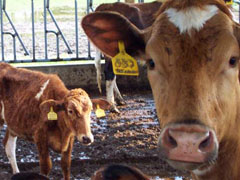


However, we earn our money by metaphorically killing animals, cutting life, planting, gathering, digging, or just being at the job and doing what we are told. We can also find stories in all these different ways.
Not all stories are told for entertainment: every discipline has its narrative so that doctors learn from case studies, lawyers from trials, and schoolchildren from educational narratives. These real life stories may not differ that much from our fictive creations, as in courtroom dramas, detective thrillers, or historical period pieces. Creating your own story is a form of empowerment, giving you a feel for some of the omnipotence of the Creator, so when the story lands in your lap, do you still see its potential?
A story is not the same as a dramatic structure that we manipulate, although some stories seem as if they were created by a top dramatist. A story is simply what happens to specific people or personified objects in a specific time and place. There may be 36 dramatic situations but there are millions of stories because people are unique.
When we pick a story from life, we take it out of its world, an excision that will determine the level of reality, be it documentary, naturalistic, realistic, romantic, fantasy, sci fi, or surreal. As you write, the reality may change, but remember the world that originally gave birth to your story.
Examine the world in which the story is created:
a) American naturalistic contemporary,
b) global indigenous,
c) historical or period,
d) sci fi,
e) aesthetic-- surrealist, impressionist, i.e. blue lens over the set as in Blue Velvet,
f) musical,
g) animation,
h) cyberspace,
i) extreme outdoor set,
j) fantasy elements but not complete sci fi. Superman Spiderman etc.
How does the protagonist's objective connect to the his or her world?
75 % of my students have this motive-- to establish a career, or get a good grade, or get into a good school. This won't work for a feature film unless it leads to higher stakes, such as a crime, insipid politics, undying love, or the ability to sacrifice for an ideal. Otherwise people won't identify with this. Or you go into a supernatural realm and you really get supernatural powers. But these mundane, petty motives don't work.
Examine the subject matter or area where main motivations occur, such as:
a) love, including sex, obsession, self-love, family love, and companionship--brotherhood, sisterhood. includes hate
b) money for greed or survival, not just the mundane weekly salary unless the character is starving
c) fame-- adulation of everyone
d) power-- governmental politics but all power plays with high stakes
e) ideals-- religious, or freedom, honesty, even magical or superhuman power -- as long as character is willing to sacrifice for them
f) crime-- anything that is against the law-- theft, murder, rape, arson, conspiracy, embezzlement-- from the point of view of the victim, (thriller) the lawyers (courtroom), detective, perpetrators (gangster) etc. Western can be in crime or war or both.
g) war-- legitimate and illegitimate wars-- between real or fictional characters with all the devastation, honor, patriotism, horror that this implies.
h) adventure-- i.e. anything for fun, battling nature for outdoor sports, or teams for sports, concerts etc. The goal is to have fun. The mode is action.
i) birth-- the desire to give birth, if you can't, either literally to a baby or to an invention or idea, or coming of age-- to give birth to an older, more mature self as in BIG.
j) death-- fighting addictions, fighting diseases, shamans, doctors, patients etc.
k) disaster--natural or manmade--where fighting the disaster is the focus more than a war or a plague which would be in other categories.
In Waiting for Godot, it is about the hope for or absence of God, hope, higher power; it isn't really about waiting for godot. Exit the King is about fighting death with an existential appreciation of life. Motivations need not be conscious or wilful.
Sometimes you must spend a long time researching the world of your story. To write my trilogy, How to Survive as an Adjunct Professor by Wrestling, I had to go over and over the events in New York after September 11, travel to Egypt, Turkey, Morocco, and Paris, and study cosmology, particle physics, the Muslim religion, and American foreign policy. For my Huguenot St. novel/screenplay, I have had to research geology, Native American tribes and culture, Huguenot religious persecution, small town politics, seventeenth century history of the Hudson Valley and Shawangunks, and various immigrant habits and cultures.
Imagine what the writers had to do to find and create their stories.
Dramatic Structure |
Dramatic Structure is the organization of conflict between characters in their world. Cut, carve and cook it, simmer, sauté, bake, broil, boil, or serve your meat raw and bleeding. Stay here for the mountain versus the circle, but for Boolean layers, caravan tales, and other paradigms influenced by twentieth century physics, and how world cultures experience time and space analyze each work separtely.
Steam-the Aristotelian pressure cooker.When you steam food, you preserve the texture and vitamins, but you make it really hot. If you steam too long, it will wilt or get soggy; if you don't steam enough, part of it remains cold.
Coffee benefits from the steaming process and sometimes makes us think more sharply.
Drama began from our love and need for imitation, harmony and rhythm. Tragedy is an imitation of characters of noble birth and comedy of inferior types whose flaws are so exaggerated and real that we can laugh at them. Tragedy is an imitation of an action that is serious, complete and of a certain magnitude, in language embellished with each kind of ornament, through pity and fear effecting the proper purgation of the audience's emotions.Pity is aroused by unmerited misfortune; fear by the misfortune of a man like ourselves. Every tragedy must have six parts: Plot, Character, Diction, Thought, Spectacle, Song. Aristotle feels plot is more important than character because the most beautiful colors, laid on confusedly, will not give as much pleasure as the chalk outline of a portrait. Do you agree? Spectacle is the least important. Diction involves the delivery of words that are either current, or strange, or metaphorical, or ornamental, or newly-coined, or lengthened, or contracted, or altered. The perfection of style is to be clear without being mean or too literal, vulgar, simplistic etc.
Aristotle disliked episodic drama: for tragedy to be worthwhile it had to be a well constructed story with a beginning, middle and end that proceeded from action to counteraction by necessity and probability. There is a strong connection between what he wanted from drama and what he wanted from rhetoric, although the purpose of tragedy is to purge the emotions. Tragedy must be simpler and more credible than comedy if it is to move us to tears rather than laugher. A simple plot is one which takes place without reversal or recognition. A complex plot has reversals and recognitions which should arise from the internal structure. The best form of recognition is coincident with reversal, as in OEDIPUS. Characters must be chosen in such a way that their actions raise the stakes of the drama. It's better to have family members kill each other than an enemy kill an enemy because then you can construct scenes that have the elements of betrayal, jealousy, fear, love etc. as well as anger. The DEUS EX MACHINA must only be employed for events external to the drama; the crisis/climax should arise of necessity from the inciting incident, just the way it's supposed to do in Hollywood screenplays. Every tragedy falls into two parts: complication and unravelling. Complication is every action that moves to the turning-point from good to bad fortune and unravelling is that which extends from the beginning of the change to the end.
An epic structure differs from a tragedy because it has a multiplicity of plots. Epic structure is similar to what we call narrative structure. However as poetry (Homer) it was usually written in the heroic measure. Alexander Pope satirized this form in his mock epic poem THE RAPE OF THE LOCK in the eighteenth century. Epic tales can be longer, more complicated, more irrational and fantastical because they are not confined to the stage.
In Western drama the most important thing is a hero who badly wants something he can't get; in world mythology, it is the call to adventure to undertake a journey, implying that there are archetypal forces even stronger than the hero's objective. The first is a paradigm of time, heightened by compressing events in space into a limited time span; while the second is a paradigm of space that takes the hero away from the Ordinary World to transform enough in the Special World so he can bring back an elixir to community. Return, resurrection, rescue, archetypes, threshold struggle are some of the terms pitted against plot points, throughlines, premises, reversals, crisis/climax/denouement. While high concept screenplays involve the community and transformative dramas develop character transformation, in the Campbell paradigm, the hero's transformation is a resurrection that brings the community full circle. Campbell's work is motivated by his spiritual search and his recording of stories that transcend the hero's objective to connect to a more universal truth. Many Western stories stay with the self, its foibles, flaws, frustrations, and final triumph in getting what it wants.
The French dramatist, Georges Polti, categorized 36 dramatic situations, that presumably encompass all the major conflicts between characters in drama. If you are basing your story on real life, and want to raise the stakes, you can use one or more of these situations to cook your characters.
Supplication
Crime Pursued by Vengeance
Vengeance Taken for Kindred upon Kindred
Pursuit
Disaster
Falling Prey to Cruelty or Misfortune
Revolt
Daring Enterprise
Abduction
The Enigma
Obtaining
Enmity of Kinsmen
Rivalry of Kinsmen
Murderous Adultery
Madness
Fatal Imprudence
Involuntary Crimes of Love
Slaying of a Kinsman Unrecognized
Self-sacrificing for an Ideal
Self-sacrifice for Kindred
All Sacrificed for a Passion
Necessity of Sacrificing Loved Ones
Rivalry of Superior and Inferior
Adultery
Crimes of Love
Discovery of the Dishonor of a Loved One
Obstacles to Love
An Enemy Loved
Ambition
Conflict with a God
Mistaken Jealousy
Erroneous Judgment
Remorse
Recovery of a Lost One
Loss of Loved Ones
Think of what steam does. It cooks the ingredients while maintaining their integrity. When you steam fish and vegetables, you eat fish and vegetables, not a casserole. 
 Fried food is a fast way to cook, one that allows you to see what you are doing, and to make fattening food crispy.
Fried food is a fast way to cook, one that allows you to see what you are doing, and to make fattening food crispy.  Bread is usually toasted to give it a crispy flavor, and then plastered with butter and jam, while indigenous cultures generally bake their bread. Pizza can be cooked in a microwave oven, which shortens the cooking time with infra-red waves. Americans don't want to wait too long for the action to begin. Laborous expositions bore them. Americans like to put fruits and vegetables into the blender, or make homogenized milk.
Bread is usually toasted to give it a crispy flavor, and then plastered with butter and jam, while indigenous cultures generally bake their bread. Pizza can be cooked in a microwave oven, which shortens the cooking time with infra-red waves. Americans don't want to wait too long for the action to begin. Laborous expositions bore them. Americans like to put fruits and vegetables into the blender, or make homogenized milk. For a culture that is made up of immigrants, Americans tend to homogenize their stories.
For a culture that is made up of immigrants, Americans tend to homogenize their stories.
 Or dice vegetables so they will have a uniform appearance. They like extreme temperature changes, freezing milk and cream into ice cream.
Or dice vegetables so they will have a uniform appearance. They like extreme temperature changes, freezing milk and cream into ice cream.
 Many Americans fry their veggies as well as their carbs and protein, making everything as fattening as possible. Yet, in one sense, they like their dramas lean and mean: a theme, a task, a team, a deadline, a competition, a consequence-- you're fired--but that can also be influenced by sequencing and plot complexity.
Many Americans fry their veggies as well as their carbs and protein, making everything as fattening as possible. Yet, in one sense, they like their dramas lean and mean: a theme, a task, a team, a deadline, a competition, a consequence-- you're fired--but that can also be influenced by sequencing and plot complexity.
Dramatic structure, how the conflict unfolds, is not the same as narrative structure, the sequence of events in time and space colored by the POV of the narrator. Dramatic structure is the conflict between protagonist and antagonists as they fight for their through-lines in response to the Central Dramatic Question, a visual paradigm similar to falling off a cliff from catalyst to commitment to confrontation to cataclysm to chaos, crisis, climax and conclusion, timed by plot points. Emotion is consummated in a catharsis.
Americans still find Aristotle useful now for his catharsis and definition of unities of space, time and action and priorities of plot, character, thought, diction, song, spectacle. Shakespeare is good for the gap between expectations and result, colored by the character's dilemma and necessity to choose, a sequence of choices, which reveals deep character. While Americans can't compete with Shakespeare's language, nor do they want to, they have the same epic sense of crisis and climax and its effect on the community. However, they tend to prefer transformational drama to a tragedy where the hero dies. The hero is often a commoner who makes good rather than an aristocrat who falls, reinforcing the democratic social system of American culture.
While the plot points are a paradigm mainly of time, the monomyth is a paradigm of space. The circular journey from ordinary to special world and back and the stages of this journey from call to adventure, to crossing the threshold, approaching the inmost cave, returning resurrected and getting or giving the elixir are similar to plot points except that the spatial aspects represent a circle rather than falling off a cliff, thereby making the set-up and conclusion a bit longer.
Just like argumentation, drama deals with controversy, conflict and conversion in a search for truth except that logical fallacies are glorified to heighten the flaws of the tragic or comic characters. Drama must combust space and time so deadlines, planting and payoff are necessary to heighten surprise and mystery, while irony can enhance suspense and make the audience feel smart. No matter how intricate and discipline the dramatic structure, if the emotions of pity, fear, laughter or lust are not elicited in the audience, then the structure will be more like a legal case than a drama that requires catharsis to transcend the paradigms, just as wonder must transcend prosody in poetry.
World of Time: Plot Points and the Central Dramatic Question- Keefer's C's: Catalyst, Commitment, Confrontation, Chaos, Crisis, Climax, Conclusion
World of Space: Campbell Paradigm, Ordinary and Special Worlds, Bore-dinary and Extraordinary, Call to Adventure, Crossing Thresholds, Meeting with the Mentor, Approach the Inmost Cave, Reward, Resurrection, Elixir
Narrative Voice and Sequencing |
Point of View
What are the differences and similarities between narrative voice in fiction and sequencing in screenwriting? The camera decides who it likes and dislikes depending on actors but does the screenwriter control any of this?
In fiction, a story can be told in the first person, rarely the second person but it happens in some chapters of Soul Mountain by Gao Xi Jiang, third person limited, over the eyes of the main character, or third person omniscient, mimicking God, so to speak. Western readers are used to having one narrator for an entire work and often confuse the author with the narrator, while other cultures, particularly Islamic and Arabic ones, feel comfortable with multiple narrators, whose combined visions, present a rich tapestry of story. American writers often think their narrators are "objective," like scientists, allowing the story to speak for itself, but every time a story is told, there is always a point of view, even if it takes a while to decipher it.
Most of the innovative structure in timespace center on theme more than CDQ. I have explored everything but interactivity, chance and game theory. Most of the recommendations in this book assume that the writer is making choices and designing paradigms. But as with music and choreography, it is also possible to design art by the throw of the dice, so to speak, or games that engage interaction between reader and writer. These techniques surprise the writer as much as the reader, and are good ways to overcome writer's block.
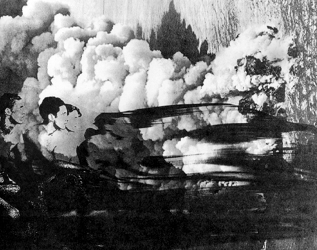
Photo Credit: Michaelsgatling
Nonlinear narrative has existed throughout history but has often been considered defective or inferior to linear narrative. As far back as classical Greece, critics said that Homer's Odyssey has fewer narrative "defects" than the Iliad because the protagonist is always present, and there are fewer loose ends. Even in the twentieth century readers and viewers have complained when a story is difficult to follow or when it it not resolved nicely. With Pulp Fiction, Quentin Tarantino allowed us to follow three stories that stopped, started, reversed and replayed themselves as easily as a VCR. With the advent of hyperfiction and hyperdrama, the timespace structures are infinite and also relative to the surfer who chooses to enter, leave, interact or even follow her own narrative. Just as Aristotelian dramaturgy reflected that culture's views of time and space, our nonlinear narrative could reflect the discoveries of quantum mechanics and cosmology, using space as a microcosm or macrocosm, time that goes back to the future or winds around itself and timespace that unites the two in Einstein's curved spacetime or Stephen Hawking's black holes. The possibilities for nonlinear narrative are endless.
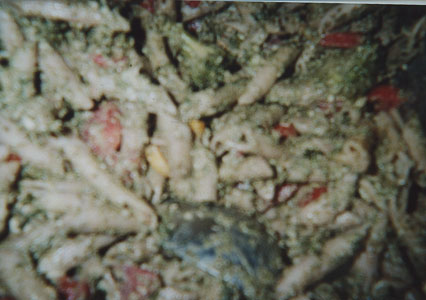 If you stay too long eating this pesto pasta, you won't be able to eat anything else!
If you stay too long eating this pesto pasta, you won't be able to eat anything else!
TIME and REALITY
The oral storyteller weaves his yarn about events that happened in the past in front of an audience, enchanting them with elements of fantasy injected into the people and places with which they are familiar, as in Arabian Nights.
The play takes place in the present even though the characters may talk about the past or future. Novels do all kinds of things with time-think of the complexity of French grammar. There is a difference between the past imperfect and the past simple, the repetition of a habit or an event worth noting. Some novelists write in the present, the past imperfect, the past simple, the conditional or subjunctive in lyric modes.
Television adheres to a meticulous, repetitive schedule of present tense narrative. Film uses present tense with flashback narrative and while it plays out in the present, can rewind or fast forward the story as in experimental films. Both TV and film can use recursive, flashback, tandem or tandem competitive as well as linear narrative. The Internet destroys time-it doesn't matter. The user enjoys or creates the story any time she wants.
For example, Alan Lightman's Einstein's Dreams describes so many ways of living time as if it were one day, going backwards, rushing to Apocalypse, turned into space, or torn between biological and mechanical time.
The smaller the space of the medium, the wider the world of it story-books and computers.
Some desserts look better wrapped, or from a distance. A close-up can make something unappetizing at times, a bit like multi-colored vomit..
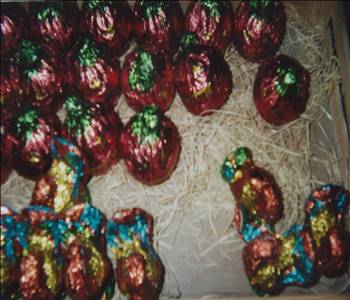
 If you begin with seafood salad, end with fruit salad.
If you begin with seafood salad, end with fruit salad. Varying the scene order
Lyrical versus Percussive
While dramatic structure relates to central dramatic question, narrative structure relates to theme, the author's attitude towards the material. Narrative structure is described by the voice of the narrator-omniscient, limited, first or third person, non-human, personified or human, distance from the story; the sequence of events in time-linear, recursive or other kinds of flashback, superimposed time or tandem competitive, past imperfect or repetition, out of time in some kinds of expository, lyrical or descriptive writing which may include the emotional subjunctive, conditional or future time expressed in the possibilities of branching narratives and indeterminate endings; and a spatial existence that can be real, imaginary, in the head, superimposed space or disembodied.
What are the unique qualities of print, oral communication, internet/small screen, or movies/big screen that create certain kinds of narrative and dramatic structures? Dramatic structures are the same in all media but narrative structures differ. The Internet is most conducive to branching narratives, tandem competitive time and superimposed space. How do written and oral communication differ? Written communication lends itself to the invisible, omniscient narrator but oral communication insists on the real character of the narrator as in Arabian Nights. Film has glorified the flashback and recursive narrative but branching narratives with indeterminate future are not popular. Run Lola Run is more of a rewind of three stories from beginning to end, rather than a future oriented piece. Film can speed up or slow down but it lives in the immediate present even when flashing back. Stage plays
RECURSIVE: The present is relatively static and the past is used to solve a problem in the present, even if that is to recapture lost time as in Proust, or to stop the plague in Ancient Greece in Oedipus Rex. While the climax of the play occurs when Oedipus plucks out his eyes, the present action up until then has been mainly conversation about dramatic events in the past. When the past is plucked, it is not replayed in a realistic, linear fashion, but filtered through the lens of the present. At the end the digs into the past cause the present to change somewhat. This is often told in first person or through the eyes of a main character. Flashback films and written memoirs, static plays like Oedipus are its forms. How do these forms differ and how do they translate into each other? Recursive is the basis of psychoanalysis where patient and psychiatrist sit in a static present using events in the past to trigger feelings to be catharsized and analyzed in order to solve problems for better action in the future. Oedipus Rex only won second prize in the playwriting competition in Ancient Greece, so some feel this kind of storytelling isn't dramatic enough. This is the basis of reflection, of the thinking we do in memoirs or at the end of the day. But it doesn't work well with multiple narrators or a huge sociological vision or a lot of action. It is for sensory recall, problem solving.
Thwarted dream, case history, life changing event. Ivan Ilyich. Rewind.
TANDEM COMPETITIVE: Stories can be in tandem without competing-sharing the same space or the same time or the same characters with some different factor. In my novel, similar characters appear in different space. It seems as if they are in the same time because they occupy the same novel, but one is in the active, impressionistic, dreamlike present and one the past imperfect, one in the eternal present of dreams and one in a specific period in society and history. They compete when they rival each other for truth from the Reader's POV. There must be a reason why stories are told in tandem. In real life, two versions of the same story are constantly competing in our minds, a phenomenon which reaches its extreme state in bipolar illness where the same state of events can be interpreted as depressing or uplifting, depending on the mood, or actions are constructed to reap those same results, depending on the mood. In other words, something exists before the story because the story is simply how specific people engage in certain events in a specific time and place. Therefore, their objectives, moods, abilities and proclivities as well as social conditions are set before the story occurs. Hence different moods and objectives can actually create somewhat different stories. We sometimes see scenes on split screen or split stage or alternating chapters of narrators in a novel. This narrative style is particularly disturbing as we don't know what kind of truth to accept and our mood is constantly jarred by the constant switches. Yet this is exactly what happens in psychosis.
LINEAR: Linear is the most common kind of storytelling in which a beginning, middle and end follows similar linearity in time and space. However, in dreams, linear storytelling does not necessarily have a cause-effect as is commonly understood. In Hollywood screenplays, script doctors are brought in to make sure there is a causal relationship to the scenes. Usually linear storytelling is told by one narrator, whether first, third or the camera, but in pass the ball linear narrative, multiple narrators carry the same story in sequence, the way storytellers passed tales through the desert from oasis to oasis through different caravans. They tried hard to be true to the story, but each storyteller obviously colored the tale based on his perceptions and values. In my second novel I chose 18 nonhuman narrators or human extensions, as McLuhan would say, to carry the story. This is a technique still used today by writers like Naguib Mahfouz, Yusuf al Qa'id in War in the Land of Egypt and Orhan Pamuk in My Name is Red. You can have multiple narrators without a linear story as in Akhenaten and some of Faulkner's work, but pass the ball linear is like the game broken telephone where narrators try to pace their addition to the story embedded in sequence within its entire history. This gives tremendous importance to the story but protects it from the fallacies of omniscient narrators like those of Tolstoy. Pass the ball linear doesn't lend itself that well to film although it is possible it could be done-something as disciplined as War in the Land of Egypt might work well. My second novel would be hard to film and keep all those narrators. Some things are too difficult to visualize in this narrative. Films and plays take place in a linear fashion but they can refer to events that occur out of sequence in time.
CONGLOMERATE:It seems that in conglomerate narrative, there must be an active throughline in the present that covers winter to winter -one year which is the surface of the rock. Then the layers are the back stories. How does this differ from recursive narrative? Recursive features the past to solve a problem in the present like Oedipus Rex; while conglomerate has a hard active linear present that covers layers of secrets, lies, and history in the past. Conglomerate is neither tandem nor competitive, nor does it deal with the future. The past is not imperfect past but singular events that influence the present. Is conglomerate the right word? The idea is that there is a superficial story with deeper stories underneath, some of which may be too disgusting, disappointing, depressing or disarming for the Reader or Viewer to stomach. For example, soap operas skim the surface of narrative, idealizing characters and romanticizing situations by avoiding depressing details. How many people lie dying with perfect hair and make-up? In a hypertext story there can be the top layer of narrative for everyone, then layers underneath which symbolize gossip, pettiness, uncomfortable facts, and finally those things that are usually censored. This would be one way to deal with Internet censorship. This is different from the usual hypertext story of branching narratives where different future outcomes are envisioned.
Repetitive structures aren't the same as descriptive films. Groundhog Day and Run Lola Run repeat. There are some changes with the different versions.
Parallel structures like The Hours are not sub-plots. The danger here is to be choppy if the sequencing isn't right and there aren't enough similarities or differences between the stories. It is like comparison and contrast in literary criticism. Choppy, flowing, choppy, flowing. But if the narrators argue, if the stories bleed into each other for a reason, it gives the whole script more depth. The Matrix has a number of parallel structures.
Instead of repetition, it might be good to spiral the action so that when characters revisit the scene they attack the problem in a different way. Sometimes the event is seen in flashback. The Unraveling-mystery structure is used with whodunits. The skill involves laying clues throughout the film and then learning the truth in the third act.
In Memento the whole film is a flashback so that it is a reverse structure. The trick is to keep the audience asking a central dramatic question. There must always be a puzzle for the audience to solve. In a circular structure there must still be linear parts. Pulp fiction has a looping structure of beginning-end-middle and more.
 Food Pyramid and Character Priorities
Food Pyramid and Character Priorities
By comparing characters to food, we determine how they were found, gathered, or killed from the story, how they will be cooked or prepared in the dramatic structure, how they will be sequenced in time and space or displayed on the dinner table, how they will be eaten, digested, eliminated, and metabolized by the audience or reader. So characters as food relate directly to story structure, genre, and audience. But there are other ways of comparing them.
Objects, Musical Instruments, Animals: Act, Hear and Feel
Food analogies aren't the only ways to create, develop, and orchestrate your characters. By comparing them to household appliances, you get a clear idea of how they act in a situation. A scissor personality is different from a vacuum cleaner, a broom, a washing machine, or a toilet bowl cleaner. Once you see how your characters clean up you may be better able to predict their actions in a scene.
Not everyone speaks the same way. Resonance, pitch, timbre, phrasing and vocabulary distinguish each character so a useful exercise is to assign a musical instrument to each character's voice. A melodious harp plays differently on our ears and psyches than a relentless drum, a schreechy violin, an ethereal flute, a banging piano, a twanging guitar,or a new age synthesizer. Every time you create dialogue, hear the sounds of these distinct instruments and let your characters respond accordingly.
In drama, we want our characters to feel instinctively and act with power.
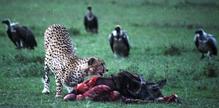
Therefore, if you assign an animal to each character, you will know how they fight, eat, have sex, and escape. A snake curls up lasciviously on the rock in the sun but will stand up, hiss, and bite if attacked; a mosquito is almost invisible until it delivers its itchy bite; a fish swims fluidly, seeking food everywhere, even on the end of a lethal hook; the gentle, slow-moving elephant can crush life with a single ponderous step; the gazelle is beautiful to look at, but if you approach, it will run away with lightning speed. The lizard blends into its environment. Your pet cat can be dressed up for Halloween. Archetypes are classic character types such as the Shadow, the Hero, the Shapeshifter, the Mentor, whose essence is related to the role they play in the dramatic journey.
Stereotypes are contemporary character types flattened and exaggerated to fit a socially identifiable role. They work best in satire, slapstick, or to provide comic relief in tragedy. If the hero of your transformational drama is a stereotype, you are in trouble.
Three-Dimensional Characters
Height, width and volume? This is a crazy nomenclature but what it means is that characters have dimensions and depth; they break stereotypes, they often act unpredictably, they have many sides to their personality, they have secrets that they hide or lie about, and they change as the story unfolds. A main character may have a kaleidoscopic personality, sounding like a violin in one scene, or a harp in the next, acting like scissors with a girlfriend, but a vacuum cleaner with his professor.
Character Profiles
Age
Looks
How they Change
Wardrobe
Body language and mannerisms
How they talk-sound of their voice
Biology, aches and pains
Musical instrument/Animal/Household appliance
Biography-where lived, degrees, jobs
Daily schedule
Exact behavior at work or school
Objectives
Fantasies
Dreams and Nightmares
Life attitude: Incurable romantic
Major delusion
Major secret
How they lie
Major embarrassment
What they want from the other characters
Whom do they love the most, hate the most?
What could make them cry?
What is the worst thing they could do?
What is their fantasy of home?
Bedroom: what it looks like and how they sleep
Sex life
Dining/living room what it looks like and what and when they eat
Entertain-How?
How do they do housework or not?
How do they walk, use gravity-lightly, heavily, sideways, gingerly, confidently
Exercise outdoors-what do they do in the Gunks?
How do they take care of their homes?
What kind of car do they drive, or not?
How would their obituary read?
On the shades of hot to cool, what color are they?
What kind of politics do they subscribe to?
Why? And does this change?
How do they groom themselves and what would they like to look like?
Sense of humor
Religious or spiritual faith
Protagonists are the protein--they build muscle, repair tissue, require lots of water to digest, and have the most long lasting effects on the audience's metabolism.
Proteins can be meat, fish, nuts, legumes, or dairy products.
If your main character is modeled on milk, how would that differ from a steak protagonist?
Junk food is the antagonist because it slowly poisons us.
Fresh fruits and vegetables are the friends, allies, and mentors.

There is a difference between the refreshing but watery taste of a cucumber, the challenging crunch of a cauliflower or broccoli stalk, and the sweet, squishy sensation of a ripe tomato.

Some vegetables, like asparagus, shallots and beets, taste better cooked, i.e. modified by intense dramatic structure. You know what that means: those are true friends in times of trouble.

Then there are the friends who are as sweet as a ripe apple, or as succulent as a bunch of grapes.
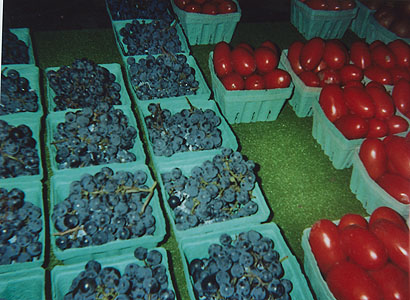
Note that any of these fruits or veggies could still act like a broom, sting like a bee, or sound like an accordion in scenes. That is what gives characters depth and unpredictability.
Grains, rice, pasta, starches are the people who make up the society, or glycogen. The fuel for action. The society.
Our carbohydrates relate to our story because some veggies or starch or plucked from vines or trees, while others are dug up from the soil. Remember to clean those root vegetables thoroughly unless you are writing a memoir.

Some carbohydrates like pumpkins have multiple uses as a dinner starch, a pumpkin pie, or a Halloween pumpkin!
Even though we may not want to get fat, we need fat in our diet to lubricate the tissue, provide energy, and improve organ function. In stories, fat can provide a love interest in action-adventure, comic relief in tragedy, or just that delicious padding that makes our scenes more seductive.
There is a difference between healthy fats like olive oil and ice cream.
 We drink bottled or tap water, fresh or canned juices, and sometimes less healthy liquids such as alcohol or coffee. They all affect our assimilation and digestion differently. A social event fueled by liquor creates a different ambiance from one where only coffee is served. How does a bar differ from Starbucks? Or a hiking trip where people just drink water
We drink bottled or tap water, fresh or canned juices, and sometimes less healthy liquids such as alcohol or coffee. They all affect our assimilation and digestion differently. A social event fueled by liquor creates a different ambiance from one where only coffee is served. How does a bar differ from Starbucks? Or a hiking trip where people just drink water
|
Character Orchestration
Everyone can't be a star, nor have the same will, energy, voice, body, and commitment. If you only eat protein, you will get kidney disease; if you only eat sugar, diabetes. Audiences require nutritional balance--all kinds of interesting characters, but a hierarchy where the protagonist and the chief antagonist take up most of the story. You don't have to cook fruits and vegetables as long as meat. Bread bakes for a long time, but at a relatively low temperature.
Content Notes on New York Literature
What was their emotional connection to the place? Was it a standard connection for the period or for the literary movements or groups in which they took part? Did they hold a distinctive view of the city? To what extent is what they lived found in the text? What is altered? Are there any descriptions of New York and if so, how are they handled? How do narrators and characters respond to their environment? Are syntax, typography or word choices influenced by the city? Because the works on which we will focus are easily divided into local writers and foreign ones, an important aim of this class will be to question the notion of belonging. We will see how some writers tried to make themselves foreigners in the city in which they grew up, and how some foreign writers wrote about their perfect cultural integration. For both groups, we will tackle the importance of race, class, gender and sexual orientation in feeling accepted. We will also try to grasp how specific time periods or cultural contexts altered living experiences in New York.
Come and meet Don DeLillo at Barnes and Noble Tuesday November 29 at 7 pm. But get there at 5. Don De Lillo is the Woody Allen of Contemporary NYC Literature, not because they write about the same things in the same way, but because he also has a distinctive style, a wry, sardonic, satirical view of life described in sentences only he could write. Although his books are very different, that style can be detected in every paragraph. He is a prognosticator of American culture and he sees with clear eyes, writes with an elegant, satirical voice, and creates poetry out of despair. Many of his 21st century novels like Cosmopolis, Body Artist, Falling Man, Point Omega et al capture the loneliness, anonymity, repetition, and spiraling-down despair of modern urban life with his simple descriptions and use of pronouns. It takes courage and confidence to capitalize on those images of falling bodies jumping from the burning Towers on September 11, and De Lillo immortalizes his artistic representation in Falling Man. “This was different, a clear sky that carried human terror in those streaking aircraft, first one, then the other, the force of men’s intent. He watched with her. Every helpless desperation set against the sky, human voices crying to God and how awful to imagine this, God’s name on the tongues of the killers and victims both, first one plane and then the other, the one that was nearly cartoon human, with flashing eyes and teeth, the second plane, the south tower.” (134) Since children weren’t allowed to watch the replay of the plane crashes, Justin, Lianne’s and Keith’s young son, watches for “Bill Lawton” in the skies with binoculars, twisting the global horror event into an absurd narrative that has its own truth.
While he plants at the beginning and pays off at the end with the shirt falling out of the sky, “arms waving like nothing in this life,” (246), he takes us through the everyday routines and drama of a failing UES marriage, the failing health of Nina, Lianne’s mother, of the failing intellects of Alzheimer’s patients in a writing support group, the failing wills of Keith and the other casino patrons, the failing stunts of the circus performer, Falling Man, emblem of narcissistic America, to the prophecy of the nation’s eventual failure: “For all the careless power of this country, let me say this, for all the danger it makes in the world, America is going to become irrelevant.” (191). As usual, De Lillo layers his structure with a plethora of interwoven plots, some connected causally, some thematically, and some through historical happenstance. Like Updike’s Terrorist, the narrator tries to imagine the world of the terrorists. Personally, I think I succeeded more in this respect than Updike or De Lillo because I went to Egypt, Morocco, and Turkey and hung out with them. I went to mosques here in Manhattan as well. They have the fame and paint the pictures better than me but they don’t understand Islam.
Jonathan Safran-Foer is fearless, energetic, trendy, and imaginative. Extremely Loud and Incredibly Close reminds me of the poems my students wrote after 9/11 that I published online. I wonder if he read those poems before he designed his typograpy. Jane Schrek wrote a poem about Einstein's Dreams where time goes backwards, the falling bodies fly back into the Towers which are pieced together again, the same thing that happens at the end of his novel. He lives in Brooklyn with his wife Nicole Krauss and teaches in the creative writing department at NYU.
Meet Oskar Schell, an inventor, Francophile, tambourine player, Shakespearean actor, jeweler, pacifist. He is nine years old. And he is on an urgent, secret search through the five boroughs of New York. His mission is to find the lock that fits a mysterious key belonging to his father, who died in the attack on the World Trade Center. An inspired creation, Oskar is alternately endearing, exasperating, and hilarious as he careens from Central Park to Coney Island to Harlem on his search. Along the way he is always dreaming up inventions to keep those he loves safe from harm. What about a birdseed shirt to let you fly away? What if you could actually hear everyone's heartbeat? His goal is hopeful, but the past speaks a loud warning in stories of those who've lost loved ones before. As Oskar roams New York, he encounters a motley assortment of characters who are all survivors in their own way. Extremely Loud and Incredibly Close boldly approaches history and tragedy with humor, tenderness, and awe.
Technically, Colum McCann is an extraordinarily gifted novelist, particularly good at character orchestration and development, which is why he won the Dublin IMPAC prize for Let the Great World Spin. I see Joyce crashing into Manhattan via the seventies slums of the Bronx. Like De Lillo, he constructs scenes that relate obliquely to 9/11 in theme and tone. McCann was born in Dublin in 1965 and began his career as a reporter for The Irish Press. In 1986 he took a bicycle tour across North America and then worked as a wilderness guide in a program for juvenile delinquents in Texas. In 1992 he married Allison Hawke and moved to Japan, where the McCanns lived for a year and a half. He and his wife then moved to New York where they currently reside with their three children, Isabella, John Michael, and Christian.
On 16 June 2009, McCann published a Bloomsday remembrance of his long-deceased grandfather, whom he met only once, and of finding him again in the pages of James Joyce's Ulysses.
On 15 June 2011, it was announced that Colum McCann had won the 2011 International IMPAC Dublin Literary Award, the most lucrative literary award in the world.It was only the second time that an author of Irish origin had won the award. McCann won the award for his novel Let the Great World Spin. The judging panel described the book as a "remarkable literary work [...] a genuinely 21st century novel that speaks to its time but is not enslaved by it", noting the book's opening pages in which "the people of New York city stand breathless and overwhelmed as a great artist dazzles them in a realm that seemed impossible until that moment; Colum McCann does the same thing in this novel, leaving the reader just as stunned as the New Yorkers, just as moved and just as grateful".
The plot of the book revolves around two central events. The first, laid out clearly in the book's opening pages, is the sensational real-life feat of the Twin Towers tightrope walk of Philippe Petit 110 stories up, performed in 1974. This lays the groundwork for the author's description of the human ability to find meaning, even in the greatest of tragedies, for which the Twin Towers serve as a sort of an allegory.
The second central event, which is only revealed halfway through the book, is the fictional courtroom trial of a New York City prostitute. This serves as a sort of point of balance, bringing the book back down to its more earthly, and therefore more real basic story lines.
In the novel the author employs the unusual literary technique of designating multiple protagonists within the same book. In fact, no fewer than 11 different protagonists are introduced throughout the course of the book, each in their own dedicated chapters. Additionally, the various protagonists are sometimes cast in roles which are naturally in conflict or tension with one another: for example, first a prostitute, and then the judge who must pass sentence upon her. In this particular case, first an earlier chapter of the book presents the courtroom story through the eyes of the prostitute, later in the book the same story is retold through the eyes of the judge.
Throughout the book the author weaves the stories of each of his protagonists through both of the two central events, exploring the personal impact that each of these two events had on the lives of each of the various protagonists. Additionally, some other issues which are unique to certain of the various protagonists are touched upon, such as the loss of a child, or the personal struggles that a member of a Catholic religious order must contend with.
While some of the story lines may pass more directly through one of the two central events than the other, all are either directly or indirectly linked to them both. Through the author's ability to draw the reader into the minds of each of the many and varied protagonists, the reader is given an in-depth and multifaceted view of both the heights and the depths of life in New York city for both its ordinary, and its more extraordinary citizens. In subsequent interviews, the author has noted his intention to point out the melodramatic tensions present in all of our lives, whether perched upon a death-defying high wire, or merely trying to live out a more "ordinary" life, "where there is still an invisible tight-rope wire that we all walk, with equally high stakes, only it is hidden to most, and only 1 inch off the ground.
Colossus of New York captures, describes, and immortalizes the naturalistic, filthy aspects of the city I try to ignore. Its brevity belies its title, in which short, staccato sentences pit pithy insights against the relentless, repetitive race that fractures time, superimposing present over past memories and miring the future in a kind of miasma consisting of depression and degeneracy. The Intuitionist is a brilliant allegory of Afro-American life at the end of the twentieth century and Zone One is a zombie book coming out this fall. A Harvard grad and Brooklyn resident, this forty-something writer is someone to watch and read.
THE BLACK VEIL: A MEMOIR
During the first decade of the 18th century, in York, Maine, a young boy called Joseph Moody accidentally shot and killed his best friend, Ebenezer Preble. Not long after, he covered his face with a handkerchief and maintained this (dis)guise until his death aged 53. Then, 120 years later, the writer Nathaniel Hawthorne stumbled across this incident and transformed it into a short story called "The Minister's Veil". A century and a half further on, a man in his mid-twenties – an unpublished novelist – admits himself to a psychiatric hospital suffering from alcoholism, chronic depression and the conviction that "I was myself a transistor radio that couldn't be tuned properly; the stereo signal kept fading in and out; I couldn't hold up my end of the contract of my birth; I was going to be raped."
In this brooding, obsessive, tragi-comic memoir, the novelist Rick Moody has finally written the book he has hinted at through his career. The motifs that have haunted his fiction – the genealogy of melancholy, America's perverse legacy of Puritanism, its relish for self-con- and de-struction, the potency of family myths and memories, history taking up residence in psychic meltdown – all are exorcised in this Book of Revelations. It is the word made flesh: Moody embodying the stories of his self.
As part of his recovery (or as a symptom of illness), young Moody embarks on a monomaniacal quest to track down his ancestry. He starts with his father and their shared love of books, a passion that takes them both to Maine and the story of Handkerchief Moody. The first question is the possibility of murder. He delves into the history of American firearms, and wonders how a nine-year-old could have accidentally triggered a musket more than five feet long which required the loading of coarse-grained powder "from a large main flask".
Yet his investigations are far from parochial or pedantic. We are given tangential chapters on America's doomed love affair with weaponry and, within pages, move to analyses of high-school massacres and how the telling of these tragedies re-writes "the inevitability" of their outcome. He jump-cuts to William Burroughs' "William Tell" shooting of his wife Joan, discussing both the necessity and unreliability of eye-witness accounts.
There is a refreshing refutation of linearity; a side-stepping of the heroic fantasy of progress. As Moody warns us, "My book and my life are written in fits, more like epilepsy than like a narrative". He riffs brilliantly on the paradox that acceptance of alcoholism is the first step to its cure, but that it is a condition which (by definition) resists acknowledgement by the sufferer. With a flourish worthy of Freud, he then compares this state to being veiled from oneself. Cue a scholarly chapter on how Hawthorne's parable of the veil has been interpreted by academics.
He gives us the New Critics' veil as one of seven types of ambiguity; the psychoanalytic veil of castration; the pragmatic reading of the veil as an emblem of William James's "sick soul". Interspersed with these intellectual somersaults are memories of his time as a graduate student, a pill-popping Derrida-quoting semiotician who "had a brush with Marxism, because to say I was a Marxist-Leninist was the thing that most irritated my parents". He remembers discovering Jack Daniels and Foucault (with equal delight), all the while going slowly mad about how "the veil itself were veiled" from his critical strategies. This is as funny as it is frantic, and Moody mocks his own neuroses even as he captures their manic clarity. The veil and his malady become metonyms for Moody the writer, statements of identity that rely upon concealment: "We need a part of us that will never be known, so that the more we reveal, the more we are enveloped in veils, layers that refuse to be known ... such that any memoir is a fiction". He adds that "many fictions are veiled memories: the two ... narrative strategies, concealing and revealing, depending upon and excluding one another by turns".This essay-memoir-travelogue-confessional could not be further removed from the victim-lit genre of breakdown and redemption. In its playfulness, candour and ambitious asides, it owes more to the lyricism of Nabokov's Speak, Memory or the irreverent charms of Dave Eggers than to the school of earnest disclosure.
Towards the end, Moody dons a veil himself. Beneath the frailty of the cloth, he embraces the weight of its significance, "a howling inside me about history and remorse and loneliness and madness and the need to capture these, somehow".In covering his face, he discovers the multitude of masks that we keep hidden from ourselves: a veil of fears confronted, and of lives connected.
The chair of our writing division thinks Black Veil is the best memoir she has ever read and even wishes she had written it. Some of you may find it heavy going. But it is an original way to design a memoir, it will make you think, and question not only the genre and yourselves, but also his innovative use of language.
Paul Auster combines Parisian expatriate energy with American postmodernism in a deconstructed detective novel.
Here comes the Guardian:
Paul Auster has created what amounts to his own, self-referential fictional world over the years, and Invisible is packed with typical Auster tropes. This is his 13th novel, and at times he seems to be both celebrating and lightly mocking his own oeuvre. There is the oddly detached male narrator roaming New York; a random dramatic incident that alters the course of a life; ruminations on the nature of writing, language and identity; multiple narrators; stories within stories; and general intertextual gadding about. And, as ever, fragments of Auster himself seem to feature – in this case, divided into two characters.
However, this makes the novel sound more arcane than it is. It is so well paced that it rocket-charges the reader through all its games and structural devices, and is a tantalising page-turner of great – if deceptive – lucidity. If we follow the initial and most persuasive version of the story, we are in Manhattan in 1967, where Adam Walker, Columbia undergraduate and aspiring poet, meets visiting professor Rudolf Born and his girlfriend Margot. The subject of Vietnam is ever present, and Born is a man of contradictory and frequently explosive political opinions. Born flatters Adam by proposing that he finance a literary magazine to be edited by the gifted student, and so begins an alliance that sees Adam engage in an affair with Margot and witness the increasingly unstable Born murder a young man who threatens him.
The book segues within moments from dinner party chatter to calculated slaughter. This is the incident on which the novel turns, and which skews Adam's life, its legacy of guilt and fury determining the direction he will take. Born, "a burnt-out soul, a shattered wreck of a person", evades arrest by decamping to Paris. Shortly thereafter, Adam follows, clearly subconsciously impelled to seek retribution, and soon he's back in Margot's bed and on Born's radar. Born, with his "blur of sophistication and depravity", is such an extravagantly creepy character, given to brilliance, manipulation and rage, that both his presence and absence cast a shadow over the entire novel. Adam's plot to exact revenge on him is so ill devised that it fails to be entirely convincing.
The story is unexpectedly taken up in 2007 by an acquaintance of Adam's at Columbia, who is now a famous author. Enter Paul Auster Mark II (possibly). Decades are covered in a sketch: the happily married Adam Walker has never achieved literary success, working instead in legal aid as a result of his role in Born's escape from justice, and he is now writing his memoir as fast as he can before he dies. In the chapters and notes he sends to the author, he writes about the death of his brother in childhood, and his own consensual sexual relationship with his sister, an episode that is later reinterpreted by the sister herself.
With the satanic Born still at large, a desperate need to know – that primitive but vital fictional engine – sends the reader scurrying to a conclusion that is more satisfying in terms of its ideas than its emotional resolution. By this time, the voices of the two possible Paul Austers have merged into one, the tale returning to the first person via the second and third, the momentum of menace increasingly powerful. Some of our assumptions come clattering down around us in a strangely satisfying way and, in exposing the mechanics of his storytelling, Auster paradoxically achieves an intensely felt authenticity. This is a fascinating and highly accomplished novel.’
“I think my old man cycle is over," Paul Auster reflected last year, on the publication of Invisible. Its twentysomething protagonist marked a departure from Auster's recent wave of old, doleful male characters. Sunset Park continues on this youthful trajectory, featuring four middle-class friends stranded in early adulthood in the present, post-credit crunch era, and squatting in a dowdy end of Brooklyn.
Their lives do not trace the innocence of youth, as Adam Walker's did in Invisible, but the stinging disappointments and unrealised ambitions of their tender age. Miles Heller is the son of a New York publisher earning his keep as a "trash-out" worker on foreclosed homes in Florida to escape his dark past. Bing Nathan is lonely, overweight and sexually confused. Ellen Brice's vocation as an artist is derailed by having to earn a living as a real-estate agent, and Alice Bergstrom is a doctoral student struggling to accept the compromises in her once vigorous relationship.
Yet there is something profoundly jarring in the book's tone. Even as the characters are shown attempting to kick-start their adult lives, their stories – written in the present tense for amplified immediacy - appear to be narrated by someone assuming a youthful ventriloquism, but not quite pulling it off. Miles's illegal love of his girlfriend, Pilar Sanchez, who has not yet reached the age of consent, is the most problematic. While it sees him fleeing Florida for fear of being caught and imprisoned, their love is presented as equal and upstanding. She might only be a high-school student but she is terribly mature for her age, the reader is repeatedly told.
However, when Miles first sees this beautiful young stranger sitting in a park, he describes his stirrings in the leering tone of a modern Humbert Humbert meeting his Lolita: "He guessed that she was even younger than sixteen, just a girl, really, and a little girl at that, a small adolescent girl wearing tight, cut-off shorts, sandals, and a skimpy halter top...No more than a baby, he said to himself." It is courageous of Auster to grapple with the disjuncture between how the world might view their illicit love and how it is felt, between them, to be wholesome.
In some ways, this follows on from his emotional investigations of illicit love in the form of incest in Invisible, when Adam embarks on a sexual relationship with his sister, Gwyn - again described in guilt-free terms.
Sadly, none of the relationships in Sunset Park is investigated in their full psychological complexity. Auster seems satisfied to stop at legitimising Miles and Pilar, and outlining the free-floating and experimental nature of youthful sexuality, rather than delving further.
Just as Auster's 2005 picaresque novel, Brooklyn Follies, captured the intersecting lives of a neighbourhood in the more affluent district of Park Slope, this novel offers another slice of Brooklyn life from the more diverse socio-economic district of Sunset Park. It stands accused of similar simplifications, particularly in its presentation of ethnic difference. Pilar's Cuban family consists of a brood of siblings with a domineering oldest sister at its helm; a bus ride across America clarifies the country to be a place of the "wheezing black woman, a sniffing Indian or Pakistani man, a bony, throat-clearing white woman of eighty and a coughing German tourist". Yet the multiculturalism is barely fleshed out beyond the briefest of pen-portraits.
Auster is a fearless, confident writer. He writes what he feels and thinks often without worrying about cliches or the opinions of others. He is prolific and powerful and bilingual French/English like Professor Keefer.
Persia Walker worked as a journalist for Associated Press and speaks fluent German. Now she is a mystery writer whose books Harlem Redux and Black Orchid Blues reveal a deep love, knowledge, and meticulous research of the Harlem Renaissance era. She was my inspiration for braving the ice storm of October 29, 2011 to go up to Harlem and see Striver's Row which is as beautiful as she described. We were lucky to have her as a Halloween guest as she is also a fabulous reader--she went to High School for Performing Arts.
Thomas Fucaluro and Todd Anderson wowed the audience with their wonderful poetry. They perform in cafes and clubs all over the city and publish with small presses and independently.
NYC's Poet Laureate: Justin Long-Moton performing at Literary New York Halloween at NYU Bookstore, October 31, 2011, 6:30 pm.
Growing up in Co-op City, Justin Long-Moton was the kid who adults said had potential. He just never seemed to come through the way they imagined.
Poetry changed his life.
As the city's Youth Poet Laureate, Long-Moton, 17, tours the five boroughs, telling young people how the arts gave him purpose and sparked an investment in improving his community.
Just two years ago, though, he was a novice, in awe of the young writers baring their souls at the 2009 Urban Word Slam Finals. Long-Moton had always enjoyed reading and writing poetry, but the slam - a competition that numerically ranks a poet's performance - inspired him in a whole new way."It's one thing to read a good book, but it's another to see it onstage, to see someone just show you everything they can," he said.
Long-Moton started writing every day, filling notebooks with his words. He also studied performance tricks on YouTube and ventured alone to open-mic nights throughout the city to test his work.
At the end of the summer, he felt ready enough to make his debut at UrbanWord NYC, the center of the spoken word and poetry scene for young people.
At weekly workshops, he found the support of writers who encouraged him and helped develop his style.
"The community we have here is like a second family," said Long-Moton. "For some people, it's their only family."
His first slam, for a $500 prize at a McDonald's on 42nd St., was a disaster. Long-Moton's poem went over the time limit and the host had to cut him short.
He got better.
"Justin has a real commitment to the craft of writing," said Michael Cirelli, executive director of Urban Word. "It's really complex and elegant. It's so evolved for someone of his age."
Slam judges recognized Long-Moton's talent as well. Last year, he led Urban Word's team to victory at the teen national finals in Los Angeles. He also took first place in the Knicks Poetry Slam and the Knicks Essay Contest.
"There was really nothing left for him to win, except for the Youth Poet Laureate Slam," said Cirelli.
The Youth Poet Laureate program is a collaborative effort between Urban Word and the Voter Assistance Commission. Each year, a poet between the ages of 16 and 19 is chosen to be an ambassador for civic engagement and voting awareness.
"We didn't want to award just the best poet, we wanted to take into account the full person," Cirelli said.
Long-Moton's community service - he has participated in food drives, AIDS walks, soup kitchens and Central Park cleanups - got him into the slam. But it was his poetry that sealed the deal.
On his library tour during National Poetry Month, he most often performs his poem "59 Ears," about his frustration with community boards and the need for young people to speak up.
"Every time I perform, I intend on changing someone's life," said Long-Moton.
He used to write about struggle. Now, Long-Moton says, he writes mostly about triumph.
His first book of poetry, part of his prize for becoming Poet Laureate, is due out in November. This fall, he'll attend Adelphi University on a full scholarship, where he'd like to study English or journalism. No matter what he chooses as a career, he says, poetry will remain his passion.
"It takes some people many, many years to find something that they want to do for the rest of their lives," he said. "I've found it and I'm only 17."
Semester II
Jennifer Egan is the Madonna of Contemporary NYC Literature. Her innovations respond to marketing and publicity so that she is always successful, milking the most of the moment as she assures her longevity. She could make a fortune in Chick Lit or romance novels but she also has a satirist's eye, the ability to create characters and scenes with a few incisive descriptions, and the linguistic talent and editorial patience to prune her work into literary novels that can still be best-sellers. She won the 2011 Pulitzer Prize and the National Book Award for A Visit from the Goon Squad. Egan is guided only by what interests her at the time of writing. "I'm kind of looking for thrills, honestly. That's what it's about." This prize-winning book was originally a bunch of short stories which she linked in a non-linear fashion where time goes backwards and forwards and as well as in a tandem-competitive fashion and chapters break off like the pauses in music. In fact her Power Point likens the pauses in music to familial communication problems. It is a smart, sleek, all-American book that almost has a horizontal hydrofracking structure drilling into the bedrock of existence to uncover the toxicity beneath. Yet she maintains an optimist, upbeat narrative as well as literary persona.
Some of the following is taken from an interview in the Guardian.
The new novel is broken into 13 interrelated stories, each focusing on a character seen out of the corner of one's eye in the previous chapter. If it sounds irksome, it is saved by pace and sheer readability. Egan is so swift and funny, so light on her feet, that her reputation lingers on the borders of chick-lit, which might explain her omission from the Orange prize shortlist in favor of more earnest titles. It's an absurd oversight, although Egan won't, of course, allow it as such. "The only thing I feel bad about is that it would have made my publishers so happy," she says. She is a great fan of Emma Donaghue's novel, Room, the favorite, which, she says, "is seriously good. It may be partly that I'm the mother of two boys, although I'm not generally interested in books that are about motherhood; I run a mile from that kind of thing. But I just found . . . it walloped me. I was in awe of what she pulled off."
Egan's writing habits are shaped by necessity. She lives in Brooklyn with her husband, a theatre director, and their two young sons. Before she picks up the boys from school she strives for five to seven pages a day, by hand. "And that can happen really quickly; I can be done with that in an hour or two. But I sometimes spend a lot of time avoiding doing it, taking four hours to do what I could've done in one. I try not to write more than that, even if I'm tempted to, because if I go too far I'm really drained for the next day. I can't do more than seven or maybe eight without jeopardizing the rhythm."
The desire to become a writer struck suddenly and without warning when she was a teenage backpacker in the early 1980s, traipsing across Europe, lonely and depressed, missing her family. This was the era of queuing for the public phone box: "There was a kind of intensity to the isolation of travel at that time that's completely gone now. You had to wait in line at a phone place, and then there weren't even answering machines. That feeling of waiting in line, paying for the phone and then not only having no one answer, but not being able to leave a message so that they would never know you called. It's hard to fathom what that disconnection felt like. But I'm actually very grateful for it. Because it was extreme. And that kind of extreme isolation showed me that I wanted to be a writer."
Why?
"I wish I knew the answer. I don't know. I think there was a kind of clarity to being reduced to myself in this extreme way. I was also really scared. I kept having what I think we would now call panic attacks. This would've been the summer of 1981 and I just thought I was flipping out. Somehow in that extreme state, I wrote constantly; harrowing journal pages where I'm narrating my own panic. 'I don't understand why I can't make it stop' – trying to understand what I was scared of." She smiles. "And I suppose the essentialness of writing for me was revealed in that experience." Egan eventually got hold of her mother on the phone, who told her to come home to California, which she did.
She could, I suggest, have written an early version of Eat Pray Love. Egan makes a face. (Reviewing that book for the New York Times, she wrote: "What's missing are the textures and confusion and unfinished business of real life, as if Gilbert were pushing these out of sight so as not to come off as dull or equivocal or downbeat.") She is a big fan of Gilbert's, she says, although not of that book.
Before leaving for Europe, Egan had had thoughts of being a medic, like her grandfather. "I loved the idea of being a doctor – plunging into the lives of different people – but also the investigative aspect of it. I was a sciency kid; I loved chemistry." Medicine fell by the wayside when she developed a squeamishness about blood in her teens. Then she wanted to be an archaeologist. "It was at that time when the Leakeys were making a lot of discoveries and it felt like archaeology was really in the headlines. My fantasy was 'wow, reconstructing lives from previous times using tiny artifacts'." She laughs to acknowledge the greater truth in this. But, "then I payed to go on a dig in summer, and found it to be kind of hot and dusty and not really what I had in mind. I realised that my fantasy had literally nothing to do with the reality."
She returned to southern California at a difficult time; her mother and stepfather had just split up; the house was sold and a lot of her stuff was gone. "I've always felt really sad about that. I'd saved so many things, for years and years. I know it's silly, but, all of my Barbie dolls with all of their clothes, preserved. It had been a terrible situation and they'd sold their house and my mother was in this apartment, and I didn't even want to be out of the room from her. I would call to her from a different room, that's how upset I was. But I recovered fairly quickly and went to college in the fall."
She used experiences from her trip around Europe for her first novel, The Invisible Circus, about a girl whose sister commits suicide on her gap year, and who retraces her steps to find out why. It's the most conventional of her novels. "It's the kind of book that makes some people cry. It's the kind of book that people say to me, gosh, when will you write another book like that?"
The idea for Goon Squad came to her after her reading group (including Ruth Danon) got stuck into Proust. It took them about seven years to plough through In Search of Lost Time, during which she became obsessed with how to represent entire lifespans, non-sequentially and in the way people actually experience them, that is as a constant negotiation between reflection and anticipation. Like the best satire, much of what Egan writes has already turned into reality; one of her characters is a hapless PR, employed by a dictator to rehabilitate his image: after the book came out, it was revealed Gaddafi had done something similar. (Public relations, in Egan's landscape, has come to manipulate human behaviour so egregiously as to be considered a branch of particle physics.) And she is experimental. The most arresting part of the novel is the chapter written in PowerPoint, by a teenage girl in the near-future, writing her online journal.
"I had a few chapters that I couldn't make work," she says. "I really wanted to write a chapter in epic verse, because I thought epic verse and PowerPoint in one novel, come on. Irresistible! But the problem is – I'd been reading Don Juan, which is just so fun and rollicking, very postmodern in that 19th-century way, where Byron is interjecting commentary about local events, making little digs at his enemies, then effortlessly flowing back into Don Juan's adventures. I thought, God, if I could do that it would be amazing. Of course, he was one of the greatest poets ever, that's why he could do it. And I'm not a poet at all. I got a couple of stanzas into that one and thought, this is a disaster."
The PowerPoint chapter manages, somehow, to be very moving and only works, she says, because the medium underlines a structural point she was trying to make about brevity: specifically, the awkward, silence-imbued relationship between a boy and his father. It's not merely a gimmick, although it looks startling on the page and I wonder that her publishers didn't protest. Yes, she says: "I thought they might say, no, this is too expensive, or too far out. And I was perfectly prepared to have that chapter be an url." She filed the first draft of the book without that chapter, and only slipped it into the final edit. "I did it sneakily. They were expecting light revisions. But I thought, all I'm going to do is make everyone frightened by telling them I'm writing in PowerPoint. And I was really possessed by the need to make it work." Inevitably, when she sent it to her agent and editor, neither could open the attachment and she had to print it out and fax it to them. She laughs. "They did not follow my instructions. My agent immediately called for technical support."
Partly as a reaction to this, Egan imagines that her next novel will be much more conventional. She's not fully into a new project yet – is at what she calls that "dangerous point" of fending off starting. Most years, she writes a couple of long magazine stories for the New York Times, and the two forms, the insularity of novel-writing, and the external movement of journalism, cross-fertilize, although she is wary of using the journalism as a displacement activity. "I always feel like I don't want to do it, and that it's getting in the way of what I want to do. I used to be able to do both at once when I didn't have kids, because I worked so much, but now I really can't. It feels like a bigger sacrifice, so I don't do quite as much journalism. But the two interact all the time. Being forced out in to the world is huge for me, it really broadens the possibilities of what I can write about."
Egan can accommodate the various roles in her life with relative ease. The difficulty she says is in the transitional moments. "When I first had a child I really had a hard time trying to figure out how it was all going to fit together. Because I felt like, when I was with him, I wanted to be writing and I should be writing. And when I was writing, I felt like I should be with him, and wanted to be with him. So I was unhappy a lot. But over time that conflict seems reduced. I can't quite explain it. They seem to intermingle more easily. It's often just getting from one to the other which is where the discomfort still lies.
"I'll walk to pick them up at school, it's 15-20 minutes, listening to music as I go, and often as I'm walking I'm uncomfortable. Miserable and depressed. But then when I see them I transfer to the other world. And their concerns are so immediate, which I find wonderful. As a writer, I'm not very interested in domesticity. But as a human, it's fantastic, because I find it so freeing. Accomplishing little domestic tasks can really give me satisfaction. I will be thrilled for having worked out some minor logistical problem with our schedule."
She finds publicity onerous. She used to be very bad at public speaking, she says, to the point where even holding the table at a dinner party would make her anxious – "six or seven people all listening to me; I didn't like that feeling of separation from them." This improved over time and she can address an audience, these days, with only occasional trouble, although in a limited way she finds fear can be useful. Working from a position of light pessimism is the thing that drives her, the thing she gets from starting each novel in a totally new genre. After Goon Squad, she is thinking around the possibility of historical fiction, a more straightforward form of storytelling, because "I'm tired of the fragmented approach, and crave a centrality."
Nonetheless, it will be new to her. "In a way, I'm always trying to do something I'm not qualified to do," she says. "So I feel that lack of qualification. And I'm scared. And I have a tendency to think things may not/probably won't work out. That's my basic mindset." It is one that, this week at least, will be difficult for Egan to maintain, although of course it's her job as a novelist to occupy multiple points of view simultaneously. She smiles. "I think the one thing that's changed over time is that I've come to realize, as a fiction writer, the fact that I don't think it will work out, doesn't mean that it actually won't."
The Kid by Sapphire. Since we are going to see her at the 92nd St Y November 21, we will include her in the syllabus. Sapphire (born Ramona Lofton on August 4, 1950, in Fort Ord, California) lives and works in New York City, and was born in Fort Ord, California. Her first collection of prose and poetry is American Dreams, published by Serpent's Tail/High Risk Books. Her work has appeared in several anthologies, including High Risk 2: Writings on Sex, Death & Subversion; Critical Condition: Women on the Edge of Violence; and Women on Women: An Anthology of American Lesbian Short Fiction. Sapphire graduated from City College in Harlem with a degree in Dance [and an M.F.A. from the writing program at Brooklyn College], where she was the 1994 recipient of the MacArthur Foundation Scholarship in Poetry. She was the first place winner in Downtown Magazine's Year of the Poet III Award for 1994.
This book is Sapphire's latest, a sequel to Push coming 15 years after its publication and one year after Precious, the film based on Push, got Academy Award attention. It is the story of Precious's son, Abdul, opening on the day of his mother's funeral. This book brings us deep into the interior life of Abdul Jones, son of Sapphire's unforgettable heroine, Precious. It is a story of survival and awakening, and of one young man's remarkable strength. We meet Abdul at age nine, on the day of his mother's funeral. Left alone to navigate in a world where love and hate sometimes hideously masquerade, forced to confront unspeakable violence, his history, and the dark corners of his own heart, Abdul claws his way toward adulthood and toward an identity he can stand behind. In a generational story that moves with the speed of thought from a Mississippi dirt farm to Harlem in its heyday; from a troubled Catholic orphanage to downtown artist's lofts, this story tells of a twenty-first-century young man's fight to find a way to the future. Intimate, terrifying, deeply alive in Abdul's journey we are witness to an artist's birth by fire, dance, and music.
Abdul, her protagonist, is the narrator of this volatile, fast-moving, brutally honest coming of age story that begins with the death of his mother, Precious, from AIDS, and takes him through a life of sexual abuse from the Catholic brothers at the orphanage, homosexual liaisons of his own, a long affair with an aging ballet master from Steps, (it's Stride in the novel to protect the guilty), to an artsy downtown life as a dancer. Professor Keefer still studies ballet at Steps but was kicked out of the professional classes taught by aging ballet masters like "Roman."As a writer, Sapphire has no fear and no censorship. Like a slam poet, she screams out her message, which is rhythmically poetic as it grates on the nerves of naturalism.
The Mambo Kings Play Songs of Love is a 1989 novel by Oscar Hijuelos.
It is about the lives of two Cuban brothers and musicians, Cesar and Nestor Castillo, who immigrate to the United States and settle in New York City in the early 1950s.
The novel won the Pulitzer Prize for Fiction in 1990, being the first novel by a United States-born Hispanic to do so.[1] It was the basis for a 1992 motion picture, The Mambo Kings, as well as a musical in 2005.
The Mambo Kings Play Songs of Love was published in 1989, and soon became a huge international bestseller. It tells the story of Cesar Castillo, an aged musician who once had a small amount of fame when he and his brother appeared on an episode of I Love Lucy in the 1950s. The book chronicles Cesar’s last hours as he sits in a seedy hotel room, drinking and listening to recordings made by his band, the Mambo Kings. Events and characters whirl through his mind, evoking what he has lost over the years: his brother and collaborator, Nestor, who spent his adult life constantly rewriting one song about a lost love; the many lovers who gave themselves up to him as he rose triumphantly through the mambo music craze of the early fifties; and the way of life that disappeared for all Cubans after that country was overthrown by an insurrection led by Fidel Castro in 1959. In telling Cesar’s story, Hijuelos weaves in cameo appearances by several real-life mambo musicians, including Desi Arnaz, Tito Puente, Pérez Prado, Machito and Mongo Santamaría.
The novel develops one of Hijuelos' most common themes: how immigrants adjust to coming to the United States.
"About four years ago, when Trump was putting up his Riverside Blvd. apartment buildings on the West Side of Manhattan and the incredibly loud construction noises were driving me (and everyone in the neighborhood) crazy, though I had given up smoking, my first impulse was to go out and buy a pack of cigarettes (which, after a few months of that exasperating nonsense, I eventually did). In any event, both the construction/noises/pollution/backed-up traffic -- all starting at about 7 a.m. -- lasted for several years. Somewhere along the line, I came to the brilliant conclusion that I tended, during periods of extended anxiety in my life, to take up smoking again; and since I'd had my first cigarettes as a kid growing up in Manhattan, and yet could remember quite calm periods in my life, when I never smoked at all, I began to write about them, the title "Thoughts Without Cigarettes" coming into my head.
Having said this, my original narrative -- a diatribe against the powers that be -- eventually turned to more inward, character forming events in my life -- and, without realizing it at first, I found myself writing about how I had come up in an immigrant working class household and, somehow, drifted into the very unpractical profession of writing fiction. Structure wise, the book is loosely organized around periods of anxiety (smoking) and of tranquility (not smoking) -- at least those were my first notions.
The difficulty of remembering the stuff I had never bothered to write down. For example, I talk about a long sojourn I had spent in Rome after publishing my first novel: if I'd turned to that narrative in 1990, a few years after I'd returned, it would have been filled with far more acutely remembered details: the thing is, as with dreams, matters of memory, which you think you will always recall, eventually turn to air with the passing of time. So for me, just conjuring up certain old events required a lot of reflection -- during which time I kicked myself for not having been the sort to keep a journal -- though I did write some things down on occasion.
Also, when it came to matters of family research -- about lineage and events that happened in Cuba decades ago, before my folks came to this country, I found that such information varied depending on who I asked.
Without going to much about the process, I will say that I was also surprised by how I became rather blunt about certain events, and in a manner that I would have never attempted in fiction: because memoirs are ( despite whatever emotions they contain) objectively, hopefully factual narratives, while novels, for example, the same kinds of things can be told much more subjectively.' (Though that habit still comes through with the memoir, especially in those places where the prose really sings.)
It's also downright astounding that Hijuelos would become a writer at all, much less one so connected to his Latino-ness. An ongoing thread of "Cigarettes" is how Hijuelos, a light-skinned blond whose cousins nicknamed him "el alemán," or "the German," has never felt Latino enough. Further isolating Hijuelos from his roots was the central, defining event of his life: At age 4, he contracted nephritis, a severe kidney infection, and spent a year in a Connecticut hospital largely in isolation, constantly undergoing nightmare-inducing medical tests. He forgot how to speak Spanish and, "when it came to the culture from which I had come, I would always remain an outsider looking in."
The author, 59, writes touchingly and even with humor of this tragic episode, as he does about the rest of his life. He grew up in a six-floor tenement in East Harlem "upper-class poor," as he and his older brother, Jose, would come to think of it, because their Pop's two cooking jobs allowed him to bring home choice edible treats. His early exposure to books consisted of comics, "the children's literature of my urban youth." His mom, Magdalena, a vivacious beauty, would never get over what could have been in Cuba and argued constantly with Pascual.
Hijuelos is, amazingly, able to look back free of bitterness. His grounding in his multiethnic neighborhood with lifelong buddies and his closeness to his brother, who teaches him to be tough and street-savvy, are among his saving graces. In an especially funny anecdote, Hijuelos cool-headedly averts a mugging as he is walking to the subway from a night class at City College. He explains to his would-be assailant that City students are poor and gives him directions to the more affluent Columbia University.
During his six years in the City University of New York system, attending various "subway schools," Hijuelos comes into his own as a writer. After he makes it to Rome as a writing fellow at the American Academy in 1985, "Mambo Kings" just spills out of him.
Among Hijuelos' charms is that, despite his success, he remains stubbornly self-deprecating, never quite believing that he's achieved his "cool-guy aspirations."
But how cool is this?
Near the end of his memoir, Hijuelos recounts how, during a White House dinner, Gabriel García Márquez, realizing he is talking to the author of "Mambo Kings," says: "That's a book I wish I had written."
Jonathan Allen Lethem (born February 19, 1964) is an American novelist, essayist and short story writer. His first novel, Gun, with Occasional Music, a genre work that mixed elements of science fiction and detective fiction, was published in 1994. It was followed by three more science fiction novels. In 1999, Lethem published Motherless Brooklyn, a National Book Critics Circle Award-winning novel that achieved mainstream success. In 2003, he published The Fortress of Solitude, which became a New York Times Best Seller. In 2005, he received a MacArthur Fellowship.
The first novel Lethem began after returning to New York City was Motherless Brooklyn, a return to the detective theme, this time maintaining objective realism while exploring subjective alterity through Lionel Essrog. His protagonist has Tourette syndrome and is obsessed with language. Lethem later said that Essrog "obviously [is] the character I’ve written with whom I most identify," and explained that the novel "stands outside myself....It’s the only one which doesn’t need me, never did. It would have found someone to write it, by necessity."[6] Upon its publication in 1999, Motherless Brooklyn won the National Book Critics Circle Award for Fiction, The Macallan Gold Dagger for crime fiction, and the Salon Book Award, and was named book of the year by Esquire.
In 2003, Lethem responded to the issue of "genre bending":
The fact is, I used to get very involved, six or seven years ago, and before that, in questions of taxonomy of genre, and in the idea—which is ultimately a political idea—that a given writer, perhaps me, could in some objective way alter or reorganize the boundaries between genres....Nowadays, I've come to feel that talking about categories, about 'high' and 'low', about genre and their boundaries and the blurring of those boundaries, all consists only of an elaborate way to avoid actually discussing what moves and interests me about books—my own, and others'. What I like are books in their homely actuality—the insides of the books, the mysterious movements of characters and situations and the emotions that accompany those movements. The play of sentences, their infinite variety.[17]
In the early 2000s, Lethem published a story collection, edited two anthologies, wrote magazine pieces, and published the 55-page novella This Shape We're In (2000). This Shape We're In was one of the first offerings from McSweeney's Books, the publishing imprint that developed from Dave Eggers' McSweeney's Quarterly Concern.
In November 2000, Lethem said that he was working on an uncharacteristically "big sprawling" novel, about a child who grows up to be a rock journalist. The novel was published in 2003, as The Fortress of Solitude. The semi-autobiographical bildungsroman features dozens of characters in a variety of milieus, but features a tale of racial tensions and boyhood in Brooklyn during the late 1970s. The main characters are two friends of different backgrounds who grew up on the same block in Boerum Hill. It was named one of nine "Editor's Choice" books of the year by The New York Times and has been published in fifteen languages.
Lethem's second collection of short fiction, Men and Cartoons, was published in late 2004. In March 2005, The Disappointment Artist, his first collection of essays, was released. On September 20, 2005, Lethem received a MacArthur Fellowship.
In September 2006, Lethem wrote the article, "The Genius of Bob Dylan", a lengthy interview with Bob Dylan, which was published in Rolling Stone magazine; the interview contained Lethem's reflections on Dylan's artistic achievements, and revealed Dylan's dissatisfaction with contemporary recording techniques and his thoughts on his own status.
After Motherless Brooklyn and The Fortress of Solitude, Lethem decided that "[i]t was time to leave Brooklyn in a literary sense anyway….I really needed to defy all that stuff about place and memory."
In early 2007, Lethem began work on Chronic City,which was published on October 13, 2009.In July 2008, Lethem said that Chronic City is "set on the Upper East Side of Manhattan, it’s strongly influenced by Saul Bellow, Philip K. Dick, Charles G. Finney and Hitchcock’s Vertigo and it concerns a circle of friends including a faded child-star actor, a cultural critic, a hack ghost-writer of autobiographies, and a city official. And it’s long and strange."
His 2007 essay The ecstasy of influence: A plagiarism is a passionate defense of plagiarism and a call for a return to a gift economy in the arts. He writes "The kernel, the soul—let us go further and say the substance, the bulk, the actual and valuable material of all human utterances—is plagiarism" and "Don't pirate my editions; do plunder my visions. The name of the game is Give All. You, reader, are welcome to my stories. They were never mine in the first place, but I gave them to you."
The acclaimed author of Motherless Brooklyn and The Fortress of Solitude returns with a roar with this gorgeous, searing portrayal of Manhattanites wrapped in their own delusions, desires, and lies.
Chase Insteadman, a handsome, inoffensive fixture on Manhattan's social scene, lives off residuals earned as a child star on a beloved sitcom called Martyr & Pesty. Chase owes his current social cachet to an ongoing tragedy much covered in the tabloids: His teenage sweetheart and fiancée, Janice Trumbull, is trapped by a layer of low-orbit mines on the International Space Station, from which she sends him rapturous and heartbreaking love letters. Like Janice, Chase is adrift, she in Earth's stratosphere, he in a vague routine punctuated by Upper East Side dinner parties. Into Chase's cloistered city enters Perkus Tooth, a wall-eyed free-range pop critic whose soaring conspiratorial riffs are fueled by high-grade marijuana, mammoth cheeseburgers, and a desperate ache for meaning. Perkus's countercultural savvy and voracious paranoia draw Chase into another Manhattan, where questions of what is real, what is fake, and who is complicit take on a life-shattering urgency. Along with Oona Laszlo, a self-loathing ghostwriter, and Richard Abneg, a hero of the Tompkins Square Park riot now working as a fixer for the billionaire mayor, Chase and Perkus attempt to unearth the answers to several mysteries that seem to offer that rarest of artifacts on an island where everything can be bought: Truth.
Like Manhattan itself, Jonathan Lethem's Chronic City is beautiful and tawdry, tragic and forgiving, devastating and antic, a stand-in for the whole world and a place utterly unique.
I met Jonathan at the Brooklyn Book Court and no, reviewers, he is not a pot-head, but a tall, handsome man who drinks more water than me and my other career is fitness! Just because Perkus Tooth is addicted to grass, caffeine, and cholesterol, doesn't mean his author is. Jonathan is as brilliant, charming, funny, moving, and memorable in real life as he is on the page. Jonathan said the inspiration for this book came as a flash when he was in Australia. Yes, the theme is about getting mired or trying to get out of one's enclosure, or to put it in astronomical terms, what orbit is the character in? Janice Trumbull is trapped in space, but so are the UES millionaires and the flawed but lovable Perkus Tooth. Only Chase tries to move between these different orbits but he isn't that successful as his adventurous trip to Inwood ends with a quick cab ride back to the UES. Jonathan has captured the essence of Brooklyn and Manhattan and is now writing a novel that takes place in Queens in the 1950s, in part because his current residence in Pomona is a bit like the fifties. Jonathan is an excellent critical and expository writer and I recommend his new Ecstasy of Influence to help you understand everything, including yourselves.
Forever is the first novel I have read in 20 years that has swept me out of my literary deconstruction, out of my Professorial analysis, into a magical fantasy that combines carefully researched New York history with an amusing, imaginative premise that engages the reader and keeps the pages turning. Hamill is a 21st century Dickens with a Bradbury imagination. He describes horrible events like the wars, the cholera epidemic, the fires, the racism, but in such a way that we accompany the narrator to a better future. To me, his descriptions of upscale dinner parties on the UES are better than those in War and Peace because I know all the real-life characters, I have been in those apartments, and its satire, scene, sensual descriptions frame and immortalize these events in a way that I could never have done.
I met Pete Hamill at the BBF and then introduced him September 24, 2011 at the NYU bookstore on ski poles after a kickboxing injury. He said that no one had ever introduced him before who had just had a kickboxing injury. However, he was won prizes from the Boxing Writers of America. Anyway, he told us the story of how he finished his first draft of Forever the evening of September 10, 2001, but when he and his family watches the Towers collapse the next morning from their downtown apartment, he realized he couldn't tell the 200-year story of New York and omit this cataclysmic event. Delphine was already working in the Towers but he couldn't just tack on the ending so he had to re-write the entire book. It was worth it.
Compare the drama of Tabloid City, a 24-hour murder mystery with deep, lonely characters to the epic Forever. Both books will give you New York in ways you have never seen it.
We begin and end with Hamill's Forever, one of my favorite books because of how it compresses the history of New York, remaining true to geography, and embeds a marvelous fantasy element with the character who lives through centuries. Perhaps this is a fantasy of mine! Hamill wished me long life and laughter.Usually a long life will come with pain and loss so I will take Hamill's advice and laugh as much as I can.